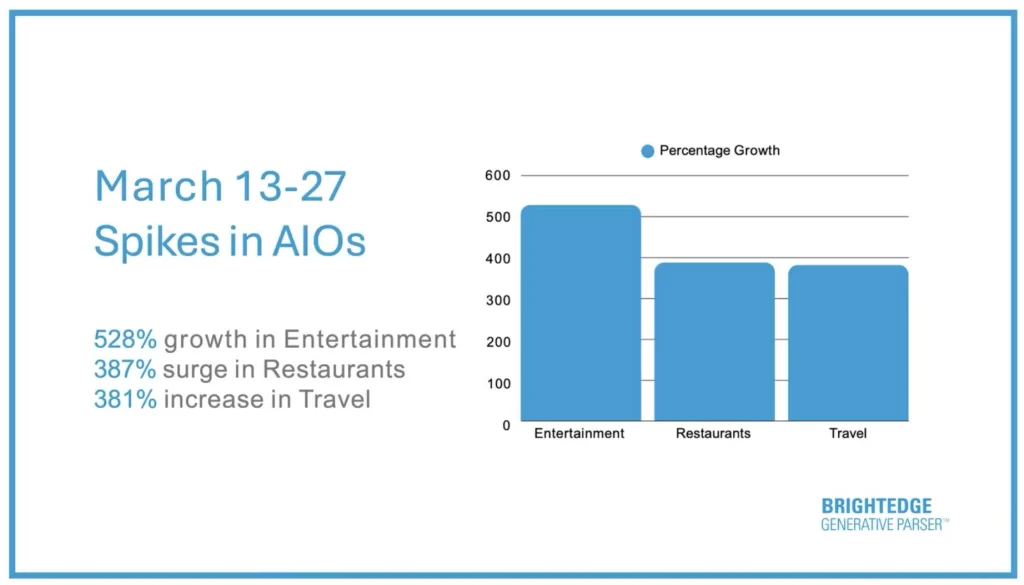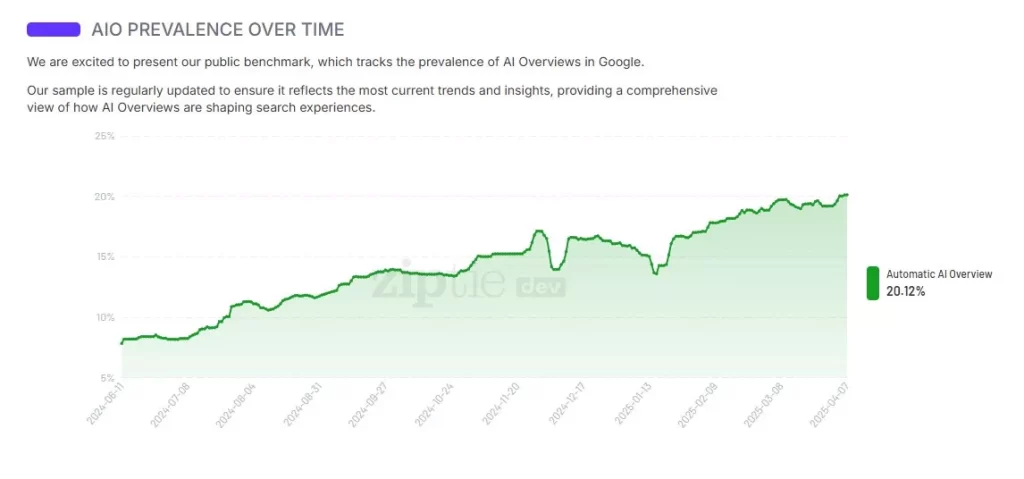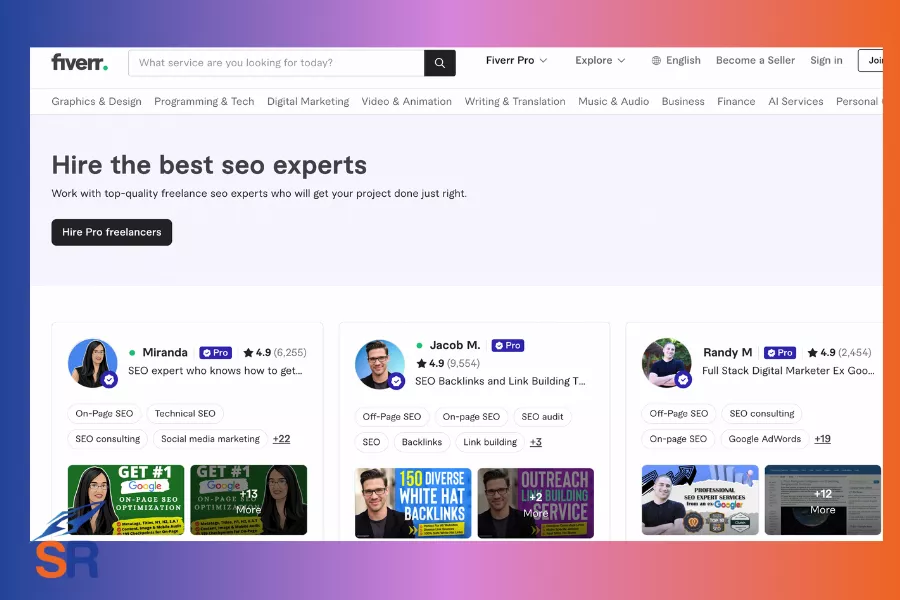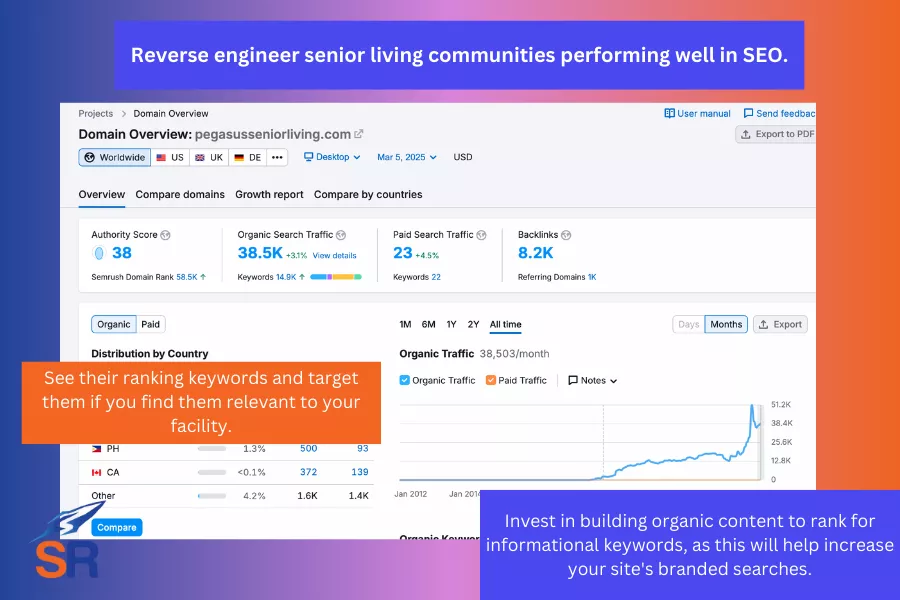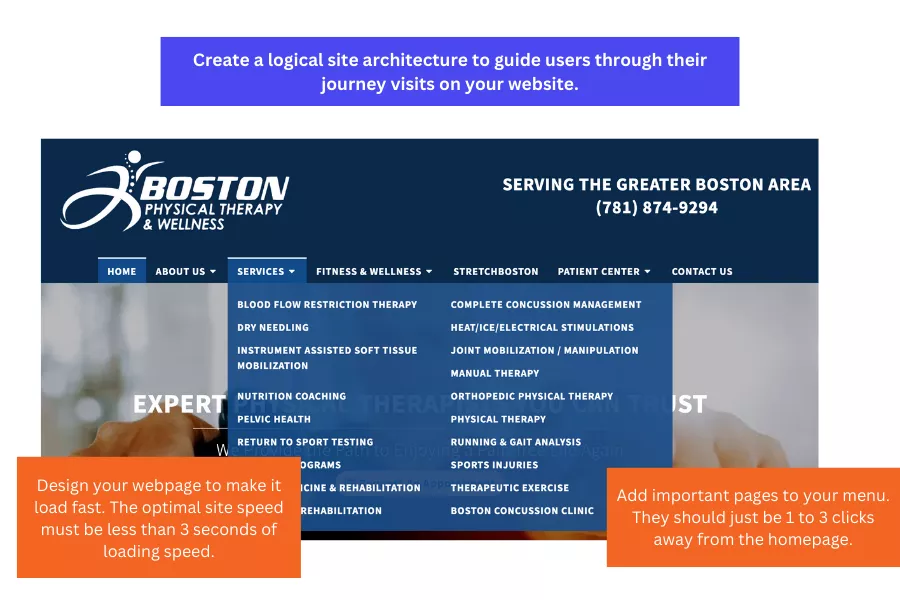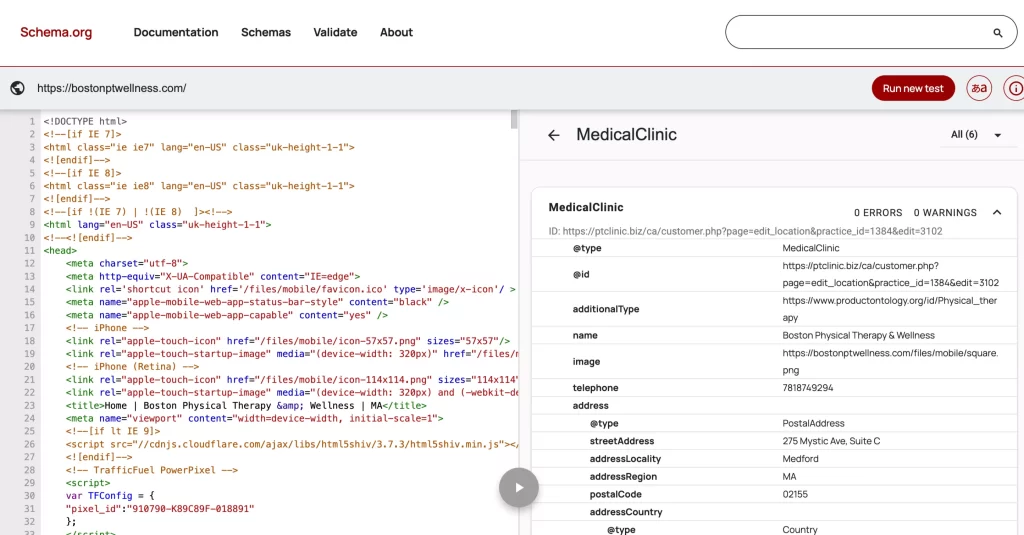How to Rank in Google AI Overviews [2025 SEO Guide]
Google's AI Overviews (AIOs) are now a major part of search. In the March 2025 core update, AIOs expanded sharply across entertainment, restaurants, and travel, appearing more often at the top of search results.
According to recent analysis by Glen Gabe, AIO visibility has crossed 20% for the first time ever. Verticals like real estate and eCommerce are also starting to see growth in AIO exposure. This only shows a clear shift that Google is giving more space to AI-generated summaries, and businesses need to adapt.
What are Google AI Overviews?
Google AI Overviews is a search feature that uses generative AI to give users quick, summarized answers at the top of search results. It is powered by Google's Gemini AI model, which uses advanced reasoning and can process text, images, and other media to create detailed summaries.
Instead of clicking through multiple websites, users get a direct answer pulled from trusted sources across the web. These summaries are designed to save time and improve the search experience.
In this post, I decided to make a detailed practical guide on how to rank for AI overviews.
1. Achieve Top Rankings on Organic Search Listings
To appear in Google's AI Overviews, your first goal should be to rank high in traditional search results. One common misunderstanding is that AI-generated content pulls from a completely separate pool of information.
In reality, AI Overviews rely heavily on the same top-ranking pages that appear in the main search engine results pages (SERPs). Though I've seen SERPs with AI Overviews pulling data from websites on page 2, ranking on AI Overviews is much easier if you're within the top rankings for your target keywords.
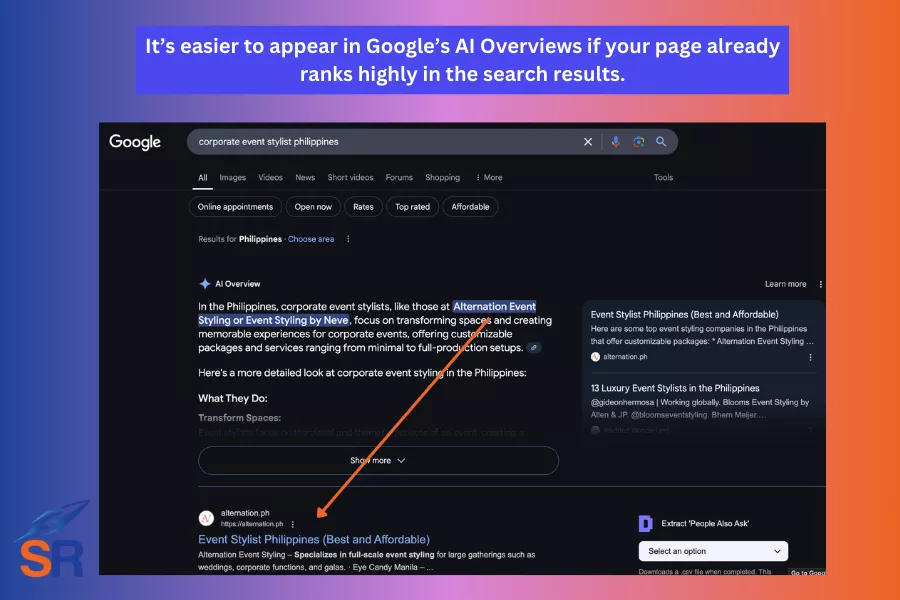
Google's AI system scans trusted, authoritative sources and those that are usually the pages already ranking well. The AI then summarizes key points from these sources to generate the overview shown at the top of the results.
To increase your chances of being included:
- Focus on strong on-page SEO fundamentals. Optimize target keyword in titles, headers, URL structure, and write for a better contextual understanding of your page.
- Match the search intent precisely. Give direct, clear, structured answers if the query is informational. Avoid fluff and vague explanations.
- Use question-style subheadings (e.g., "What is..?", "How does…?") and follow them with accurate, concise answers (these are the types of structure that make it easier for Google's AI to extract useful information).
- Improve UX by fixing technical issues. On one of my own sites, after fixing its Core Web Vitals issues, it directly helped surface in AI Overviews.
Without these basic hygienic optimizations, your content won't be in the running for AI Overview inclusion.
2. Reverse Engineer the Sources That Feed AI Overviews
To increase your likelihood of appearing in Google's AI Overviews, you need to understand where the AI pulls its information from and how to get your brand mentioned in those places.
AI Overviews rely on a mix of high-ranking sources, link mentions, and even unlinked brand references to build accurate and context-rich summaries. Unlike traditional snippets that pull from a single page, AIOs synthesize insights from multiple authoritative sources.
Here's how to reverse-engineer these sources and improve your brand's visibility and presence:
Search like your customers. Use queries like "best [product type] for [use case]", "[competitor] alternatives", or "top [industry] tools". Look at what pages appear in those search engine results pages.
Create an inventory of the content types that consistently appear. You'll often find these content types and structures:
- "Best of" listicles
- Review platforms (e.g., for SaaS keywords, software review platforms include G2, Capterra, and TrustRadius)
- Industry-specific blogs and trade publications
- Media outlets that Google considers reliable and trustworthy
Once you have a list of these sources, you can launch a digital PR campaign and strategic link building campaign that gets you mentioned or linked from these sources (don't ignore unlinked brand mentions, as they can also influence what AI Overviews include).
Google's AI values context, credibility, and diversity of input. When your brand is mentioned across multiple high-authority sites, especially in comparison-style or recommendation-focused content, it signals trust, and that increases your chances of showing up in AI-generated answers.
3. Feed AI Overviews with the Right Content Types
This tip builds on the previous strategy. While it's important to get your brand mentioned by external sources, it's just as critical to publish the kind of content AI overviews are likely to use.
You can focus on publishing content types to help Google AI Overviews easily extract and summarize key information from your site. These content types should be structured, relevant, and optimized for clarity, making it easier for the AI to pull accurate insights and display your content in search overviews.

Start with high-impact formats such as:
- List-style content: Posts like "Best Tools for [X]", "Top Alternatives to [Competitor]", or "Best Software for [Use Case]" to give Google clear comparisons and structured information, which are ideal for summary generation.
- Comparison pages: Content such as "[Your Brand] vs [Competitor]" provides side-by-side breakdowns of features, pricing, and benefits, now being used in AI Overviews given that they answer common buyer-intent questions directly.
- Feature-focused landing pages: Create separate, well-structured pages for each product, service, or solution and optimize them better to satisfy searchers' intent and needs by including clear headers, bullet points, and FAQs that explain key benefits, integrations, and use cases.
- FAQ and FUQ hubs: Publish dedicated FAQ and FUQ (Frequently Unasked Questions) pages that address specific questions your target users are likely to search for answers yet, but are not commonly asked. Then, format these answers clearly and include keywords naturally for better relevance.
- Use-case and industry pages: Showcase how your product or service solves problems for specific industries, avatars, or roles, helping it to match long-tail, intent-based queries that are often pulled into AI Overviews.
The main objective is to mirror the types of sources that AI Overviews pull from while structuring your content to make it easy to scan, cite, and summarize.
By creating a content library of these assets on your site, you improve your site's visibility in traditional search and feed the AI system exactly the type of content it looks for when generating search overviews.
4. Include Original Data and Insights
One of the most effective ways to stand out in Google's AI Overviews (and I've tested it a couple of times) is by adding original information that provides real value beyond what's already on the web ("information gain").
Information gain refers to the idea of content that should offer something new, not just rephrase what already exists. It should be based on actual experiences and expertise that happen in the offline world.
To achieve this, you can focus on publishing content assets that include:
- Original research or surveys
- Proprietary data or performance metrics (every industry tracks performance)
- Expert commentary or quotes from subject matter experts (SMEs)
- Case studies with measurable outcomes
- Unique analysis or trends not commonly cited elsewhere
When crafting these content assets, I'd like to improve the reading experience for my target audience. Here are the critical steps to do it:
- Use clear formatting such as bullet points, tables, and visuals to make your insights easy for AI to process and summarize.
- Cite sources and credentials. If you're quoting an expert, include their name, title, and relevant background to establish authority.
- Include a brief methodology for any study or data you present.
Let your site's content library add to the body of knowledge on the subject matter of your choice (always bring something new to the table).
5. Increase Visibility in the Entire SERP Ecosystem
The SERP ecosystem is now filled with multiple content types and platforms, all of which can influence what appears in AI Overviews. Search for any high-value keyword, and you'll see a crowded SERP.
To improve your brand's chances of appearing in AI Overviews, you need to increase your brand's presence across all relevant SERP elements (not just organic links to your own domain).
Here are actionable tips to consider a holistic SEO (and brand marketing) approach:
- Create, optimize, and publish video content, helping it rank in carousels and be referenced in AI-generated summaries.
- Join discussions on Reddit. Add value to the discussions and relevant threads or subreddits where your target audience hangs out (as you know, Reddit posts often appear in search results and are now cited in AIOs). Check out this guide on using Reddit for SEO and content marketing.
- Leverage multi-format content by turning blog posts into videos, infographics, and interactive content to allow your content to show in various result types.
Increase the number of touchpoints your brand has in the SERP, as this can significantly affect your exposure to both users and Google's AI systems.
6. Optimize For Content Depth and Better Content Structure
Content depth isn't about writing longer content to reach a certain word count. It's about writing complete and relevant content that answers your audience's real questions.
AI Overviews pulled information from sources that demonstrate strong topical coverage. This means that your content should go beyond surface-level information and directly address the types of questions your ideal customer profile (ICP) would ask (even if those queries don't have high search volume).
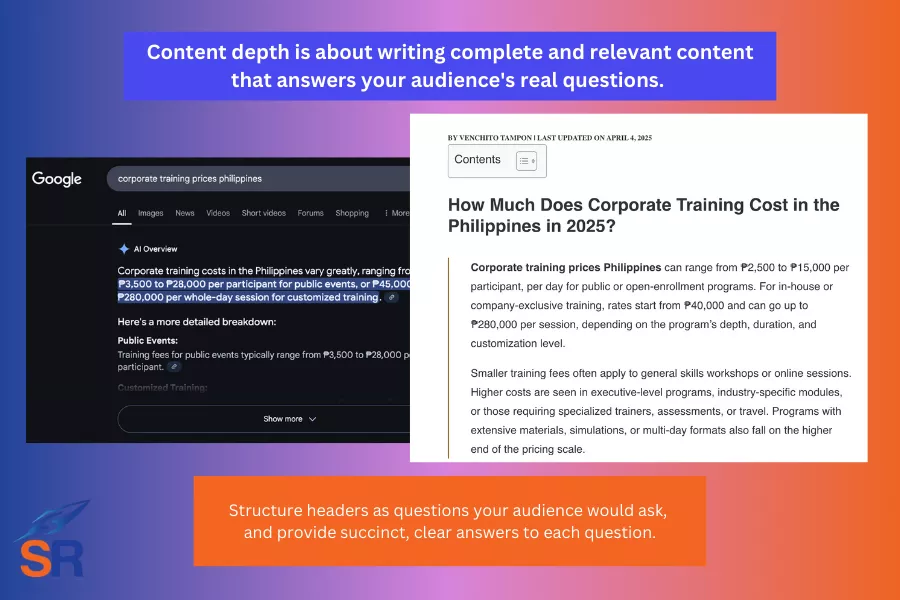
I've seen SERPs with AI Overviews that have been pulling content from lower domain rating websites, as long as the specific page covers the topic comprehensively and clearly. Now, it gives chances for smaller brands to compete if they genuinely provide content depth and better structure.
Here's how to optimize your content for content depth and structure:
- Use conversational phrasing and real questions. Structure headers as questions your audience would ask, and provide succinct, clear answers to each question.
- Organize content for scanning and summarization. Use bullet points, numbered lists, and short paragraphs (making it easy for the AI to understand and extract value).
- Implement schema markup (like FAQ schema, HowTo, Review, Article, etc..) to help Google better understand your content's purpose and format.
- Highlight unique insights or complete coverage—make your content more comprehensive than other sites' "ultimate guides" pages.
If you focus on clarity, topical completeness, and proper content formatting, even if you're a small site, you can become a go-to source for highly sub-niche topics for Google's AI-generated summaries.
7. Track Your AI Overview Brand Mentions Against The Competition
As AI-generated summaries often answer user queries directly, you'll notice a reduction in the number of clicks to individual websites (as users instantly consume the content right from Google without clicking the websites, even when those sites are the source of the information).
One way for brands to become competitive is to track how often they're mentioned in AI Overviews and how that visibility stacks up against competitors. Tools like Ahrefs' Brand Radar have become valuable in this matter. Though they're still in Beta mode as of this writing, it can help you generate the data and insights you need to track a brand's standing on AI Overviews.
Ahrefs' Brands Radar tool can help you monitor and measure your brand's exposure within AI Overviews. Here's what it enables you to do:
- Monitor your market's AI search activity. See how frequently AI Overviews appear for questions and phrases related to your primary keyword, and identify if those queries are driving those results.
- Track your brand mentions in AIOs over time. Understand how often your brand is cited, referenced, or included in AI-generated summaries across key topics.
- Compare visibility against competitors. Benchmark your brand's AIO presence next to other companies in your space, which will help you spot gaps and competitive advantages.
- Identify new AIO content opportunities. Analyze which types of content get pulled into Overviews and adjust (or add more efforts) to your content strategy to target similar formats or topics.
- Monitor brand sentiments in AIOs. Check whether your brand is being mentioned in a positive, neutral, or negative context within AI responses (giving you insights into public perception as reflected by AI systems).
You need a clearer and bigger picture of your true brand reach in search Overviews beyond clicks and impressions.
There you go, seven actionable tips to help you rank for AI Overviews. If you need help with search engine optimization or link building, send us your needs, and we'll be glad to help.
Local SEO Guide for Businesses in the Philippines
The Philippine SEO market is ripe for new businesses to promote their products or services by ranking for industry-related keywords to increase their website's organic traffic and leads.
With more Filipinos using Google to find nearby stores, restaurants, clinics, and services, local SEO in the Philippines has become a key strategy for business growth.
If your business depends on foot traffic, deliveries, or local word-of-mouth, learning how to do local SEO in the Philippines can give you an edge over your competitors.
As many digital marketers are overly focused on paid advertising, such as meta ads, there's room for any business owner to get traffic from a channel most businesses overlook.
By definition, local SEO is the process of improving your brand's visibility on Google for searches in a specific area. Unlike regular SEO, local SEO focuses not just on website rankings but also on appearing in the local map packs, which are the top 3 business listings that show up at the top of search results with a map.
It helps your business gain the necessary visibility at the top of local business map packs displayed on top of organic search results pages.
I have my fair share of rankings for local keywords for my own businesses, including our coffee franchise, corporate training company, and our SEO agency, which ranks #1 for "link building agency Philippines."
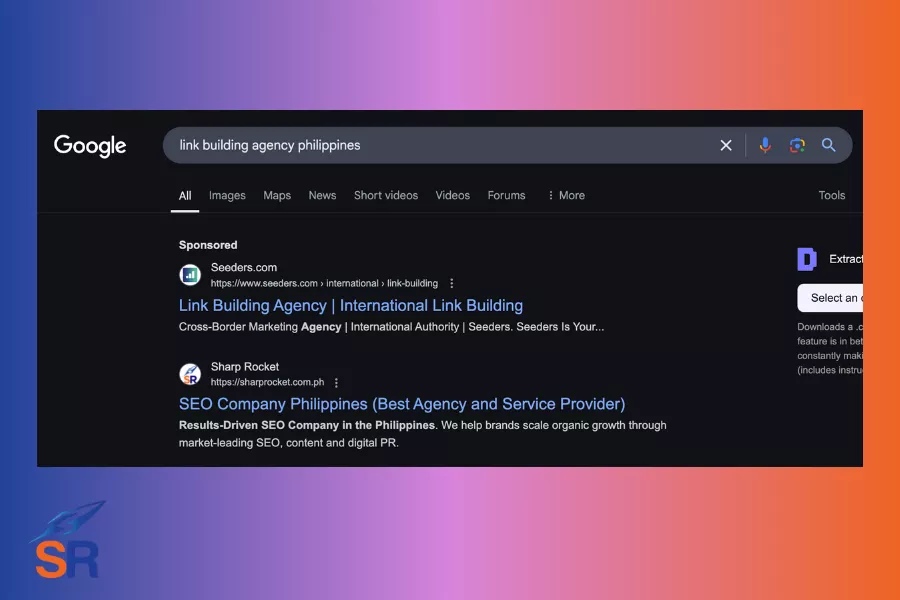
This guide covers practical, actionable SEO strategies to help you appear in local map packs and organic search listings. And it's now the right time for local businesses to jump into local SEO and capture traffic their competitors may have missed.
1. Optimize Your Google Business Profile
One of the first high-impact techniques for a local SEO campaign is optimizing your Google Business Profile (GBP). Your GBP is often the first thing people see when they search for a service near them.
Most local businesses in the Philippines don't recognize the power of GBP in proportion to how it could drive nearby customers to visit their local businesses. While they could easily set up Facebook, Instagram, and TikTok profiles, most local businesses don't have verified Google Business Profiles.
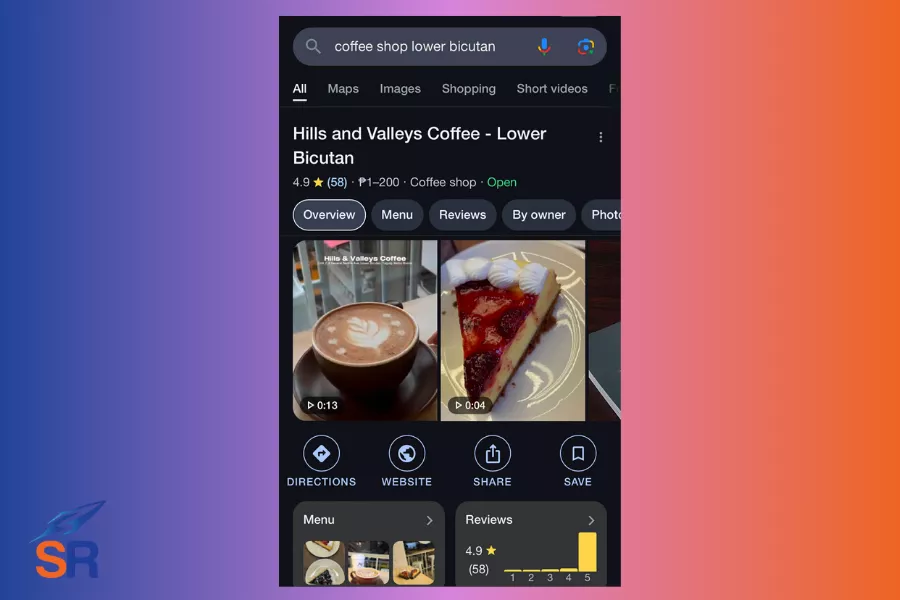
Here are a couple of tips to start verifying and optimizing your Google Business Profile:
- Claim and verify your business. Go to Google Business Profile and claim your listing. To activate your profile, complete the verification process (via mail, email, phone, or video).
- Fill out all core details. Enter accurate and consistent business information (NAP - Name, Address, and Phone Number), your website URL, business hours, and service area.
- Choose your most accurate category. Your main category tells Google what your business does. For instance, use "dental clinic" if you offer multiple services, but use "orthodontist" if you specialize in braces. You can also add secondary categories to support your other services.
- Write a clear business description that explains what you do, who you serve, and what makes your business unique. You can include local keywords naturally (e.g., "We are a family-owned Filipino bakery in Pasig, offering fresh pandesal, custom cakes, and coffee since 2002.").
- Add high-quality photos that include your storefront and signage, interior or workspace, products or services in action, and staff or team members (these photos help improve trust and engagement, getting more clicks and direction requests).
- Enable messages if you want your customers to message you directly from search results.
- Ask customers to leave reviews on your Google Business Profile. You can also strategically place a QR code on your store to solicit reviews.
- Update your Google Business profile regularly by posting new offers, products, events, announcements, or tips. This sends rich local signals to Google about your profile's recent activities.
- If you change due to holidays or special events, update your business hours beforehand.
This list alone is enough to help you increase your Google Business Profile's local visibility. Completing and verifying your Google Business Profile should only take a few days, but you'll get high returns from this low-effort local SEO strategy.
2. Know Your Offer and Choose the Right Keywords
Local keyword research is one of the first and most critical steps in SEO. Before optimizing your website, fixing technical SEO issues, or building backlinks, you need to understand what your potential customers are actually typing into Google.
Search engines use keywords to match search queries to relevant businesses. If you don't use the right keywords, especially those with local intent, your business might not show up, even if your service is exactly what the user wants.
Start by clearly defining what you offer. Are you a café, a freelance web designer, a cleaning service, or a dental clinic? Then, specify your ideal customer and their location (you may probably know this at the start). These answers will certainly guide everything else in your local SEO strategy.
To top all the reasons why you need keyword research, you must uncover search terms only relevant to your business. Given that you may end up getting irrelevant traffic (as you could be ranking for other industry keywords) or get thousands of search traffic, but few actually convert into actual customers.
Here are actionable tips to help you find keywords relevant to your business.
List Down Your Services and Match with Local Search Terms
If your business offers multiple services, create a list of your offers and match them with possible location-based keywords. Here are some examples:
Use Google Autocomplete
Go to Google and type in your main product or service. Don't press enter. Just look at the dropdown suggestions.
These may reflect actual user searches. For instance, as I type the keyword "laundry service", it shows autocomplete search terms such as "laundry service Quezon City", "laundry service BGC", or "laundry service Cubao".
Use Freemium SEO Tools
You can use free SEO tools such as Google Keyword Planner, UberSuggest, and AnswerThePublic to find keywords and questions people usually search for in your local area.
If you have an extra budget, you can use paid tools such as Ahrefs or SEMRush to get keyword data with relevant search volume and keyword difficulty. These two metrics can help you decide if the specific keyword is worth optimizing pages to rank for.
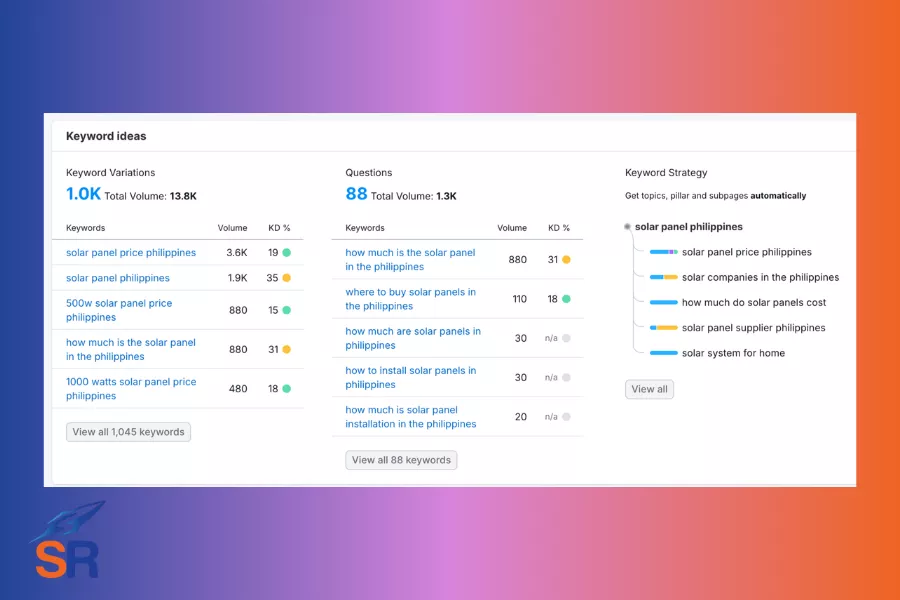
You can also enter your competitors' domains in Ahrefs or SEMRush to see what keywords they're currently ranking for, which helps you generate more keyword ideas you could potentially rank.
Pro Tip: There may not be enough search volume for your target keywords for tightly niche industries. However, if your customers are searching for them to find solutions to their needs, it's worth giving a try to create content and optimize them for those keywords (or questions).
3. Create Dedicated Landing Pages for Target Keywords
You can't rank for a keyword unless you have a dedicated page that's optimized for such a keyword.
Every keyword you want to rank for should have its focused landing page (1-to-1 keyword for each landing page). Doing so, you help search engines better understand precisely what your page is about ("topical relevance") and gives users a better experience by showing them what they need with the content that matches their search.
The best part about how SEO has evolved is that Google now understands a page's relevance through keywords, context, and user intent. It can recognize the meaning and sentiment behind your content, helping pages rank when they match what people are looking for, even if the exact keyword isn't repeated many times.
Let's examine one example. Avoid putting everything on one page if you serve multiple locations or offer different services. Instead, build a separate page for each area or offering.
| Service | Keyword Ideas |
|---|---|
| Aircon Cleaning | aircon cleaning Makati, aircon service Quezon City |
| Home Massage | home massage Manila, on-call massage Ortigas |
| Dog Grooming | dog grooming Taguig, pet grooming near me BGC |
Google ranks pages, not the whole website. So, if someone searches for "aircon repair Makati," it will favor a page specifically about "aircon repair in Makati," not a general page listing 10 cities.
I did the same for my coffee shop locations. I created a /locations page that lists the areas we serve, with links to each local page. This helps users find our brand location easily instead of mixing service and city in every URL, keeping these URLs organized and clean.
4. Add LocalBusiness Schema Markup
Adding your business name, address, and phone number (NAP) to your website is essential, but it is not enough. While your users can read this information, search engines need to understand that your NAP is official business data and not just regular text. That's where LocalBusiness Schema markup comes in.
LocalBusiness schema markup is a type of structured data that uses a standardized format (usually JSON-LD) to describe key business details in a way that search engines can quickly process and trust.
When Google sees this structured information, it gains confidence in your legitimacy and local relevance, improving your website's chances of showing in local map packs and rich search results.
If you can write HTML, follow the instructions on Schema.org. For non-coders, there are WordPress plugins to assist you with implementation.
After adding the schema, use Schema Markup Validator to check if it's working. If there are errors, fix them immediately.
5. Increase Local Relevance with Informational Content
Google favors businesses that offer more than just sales content. By covering a wide range of useful, related topics for your local audience, you send strong signals that your site is a trusted resource in your niche.
Keeping your website fresh with informational content helps acquire search traffic by ranking for top-of-the-funnel keywords. It shows Google that you're actively maintaining your site with helpful content that satisfies local search intent.
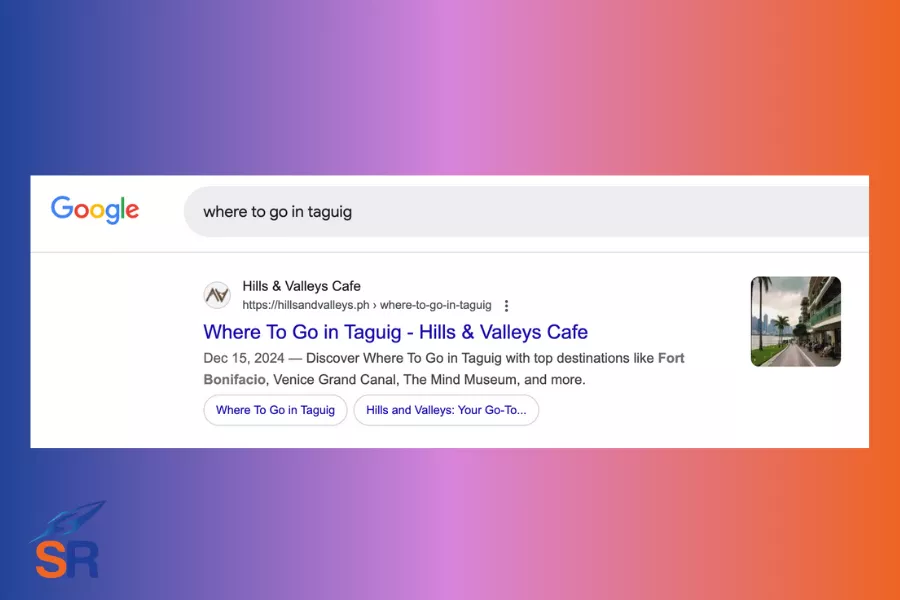
For instance, if you run a hotel in Ortigas, don't limit your content to booking pages and room descriptions. Publish helpful, location-specific content that serves potential guests and fulfills their searchers' needs.
You can publish local guides, such as:
- "Top 10 Restaurants Near Our Hotel in Ortigas"
- "Where to Go for Nightlife in Ortigas After Check-In"
- "Weekend Itinerary: 2 Days in Ortigas from Our Hotel"
These content pieces will help you rank for searches like "restaurants near Ortigas hotels", "Ortigas travel guides", or "things to do in Ortigas this weekend". Local people who are on the verge of looking for potential hotels to check in or are within the area may end up checking your booking page and potentially turn into guests.
Another way to increase your site's local relevance is to create an FAQ section that answers real questions people ask before booking. It increases your chances to rank for long-tail, location-based searches and brings visitors close to their buying decisions.
Examples are:
- "How far is the hotel from SM Megamall?"
- "Do you offer free parking in Ortigas?"
- "Can I check in early if I arrive from NAIA?"
6. Optimize Pages for Local Search with On-Page SEO
Basic optimization must be put in place when running a local SEO campaign. Part of the essentials is including the keyword in key elements of the webpage.
Starting with the title tag, you must include your target keyword with the target location. Make sure you have a title that clearly states what service or product you offer and where (e.g., "Budget Hotel in Ortigas | Book Now at [Hotel Name]").
While not considered a direct ranking factor, meta description can influence clicks. Google actually bolds the geographic location when it matches the search query.
When writing a meta description, focus on clarity and have a strong call-to-action (CTA) (e.g., "Stay near SM Megamall at [Hotel Name] in Ortigas. Affordable rooms, free parking, and easy access to public transport. Book today!").
Other on-page SEO places where you should include your keyword are H1 text, body text (by sprinkling the target keyword and its keyword variants naturally on your content), and image alt text (describe what's in the photo while including the service and location).
Do intelligent internal linking to pass link equity across other related webpages. You can use keyword-based anchor text to link to related service pages or location pages. This helps users navigate your website seamlessly through these internal links while reinforcing enough local relevance.
In many best practices in SEO, internal linking is a must-do to get other pages to rank quickly on Google's SERPs (as pages with significant traffic could help pass more link value to its different internal pages).
7. Build Local Links and Citations
If the above optimization isn't enough to rank for local keywords in the Philippines, where you'll likely be competing for mid-level to highly competitive keywords, you need an off-page SEO strategy to get backlinks from sources within the country (.ph websites).
These local backlinks include:
- Local blogs
- Local news websites and publications
- Chamber of Commerce listings
- Philippine business directories (only get the legitimate ones)
- Local schools, NGOs, or event pages
Using this type of links, Google shows that trusted link sources from the Philippines can reference your business and help build your local authority.
Aside from local-specific backlinks, get citations that mention the same business information—name, address, and phone number (NAP). Think of it as your business being listed in multiple places, legitimizing its credibility and trustworthiness.
Common citation sources in the Philippines:
- Google Business Profile
- Facebook Business Page
- Yelp Philippines
- Yellow Pages PH
- Esakay.ph (for transport services)
- Real estate and job directories, depending on your industry
You can use a citation tracker like Whitespark or Brightlocal to monitor where your business is listed, fix incorrect details, and identify new citation opportunities.
If you're looking for link building services to bolster your pages' rankings or outsourcing white label SEO, book a strategy call today.
The 7 Best SEO Agencies and Services in the Philippines of 2025
Some promise quick wins, others offer vague strategies. But you need an SEO agency that drives real traffic, ranks high-impact pages, and understands your industry inside out.
We've reviewed dozens of local players to bring you this list of the seven best SEO agencies and services in the Philippines in 2025.
Whether you're a SaaS brand, eCommerce company, enterprise team or brick-and-mortar business, these agencies know how to turn search into growth.
1. SharpRocket
Best for: Link Building, Local SEO
Industries: SaaS, eCommerce, and Enterprise
Strengths: Scalable link building to drive rankings and improve organic traffic of commercial pages
Recognizable clients: Shopify, Credible, Fiddlershop, Keypath
Headquartered in Quezon City, Manila, Philippines
Founded by: Venchito Tampon and Joseph Gojo Cruz
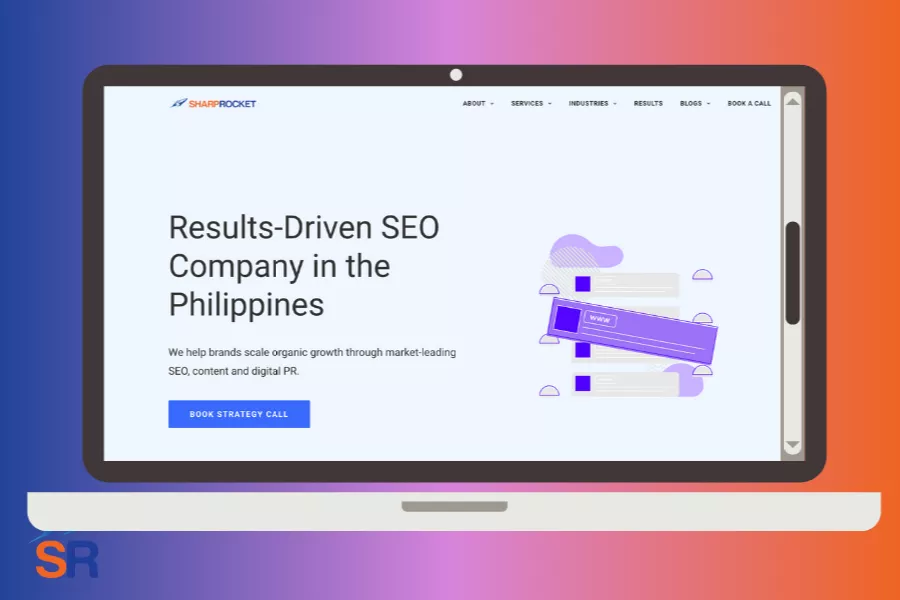
SharpRocket stands out for its ability to deliver high-impact link building services for businesses targeting competitive keywords. The agency focuses on earning high-quality, contextually relevant backlinks directly supporting a website's authority and ranking potential.
Their link building strategies are rooted in manual outreach, personalized content pitches, and strict quality standards—avoiding spammy tactics that hurt long-term results.
With deep SEO expertise and scalable outreach processes, SharpRocket has consistently helped clients secure placements on authoritative websites. This approach has played a key role in helping brands like Shopify and Credible grow their online visibility, improve rankings for key commercial pages, and generate more qualified organic traffic.
Their processes are especially effective for companies that want sustainable, white-hat link building that drives measurable business outcomes.
2. Searchworks
Best for: Enterprise SEO, Content Marketing
Industries: B2B, eCommerce, Local Businesses
Strengths: Simplified SEO Campaigns
Recognizable clients: Maya, ABS CBN, Robinsons
Headquartered in San Fernando, Pampanga, Philippines
Founded by: Glen Dimaandal

SearchWorks helps large brands simplify complex SEO. With a content-first approach and enterprise-ready solutions, they've worked with national brands like Maya and ABS-CBN to build lasting search visibility through sustainable strategies.
Their team understands how to align SEO with business goals, ensuring each project is backed by clear strategy and execution. They also offer SEO training and mentorship to internal teams, making them a trusted partner for larger organizations.
3. Avaris
Best for: SaaS SEO and Enterprise SEO
Industries: Fintech, SaaS
Strengths: SEO strategy, SEO consulting
Recognizable clients: Shopify, Salehoo, Oberlo
Headquartered in Quezon City, Manila, Philippines
Founded by: Jason Acidre

Founded by SEO veteran Jason Acidre, Avaris delivers tailored strategies to SaaS and fintech companies. Known for his thought leadership via Kaiserthesage, Jason and his team offer advanced SEO consulting that scales with enterprise needs.
Avaris doesn't rely on one-size-fits-all tactics. Instead, they conduct detailed audits and create customized plans that address a client's unique goals and challenges.
4. SEO Hacker
Best for: Local SEO
Industries: Business services, Health, Finance, B2C
Strengths: Local SEO and National SEO driving 1st page rankings
Recognizable clients: The Generics Pharmacy, Hanabishi, Motolite
Headquartered in Paranaque City, Manila, Philippines
Founded by: Sean Si
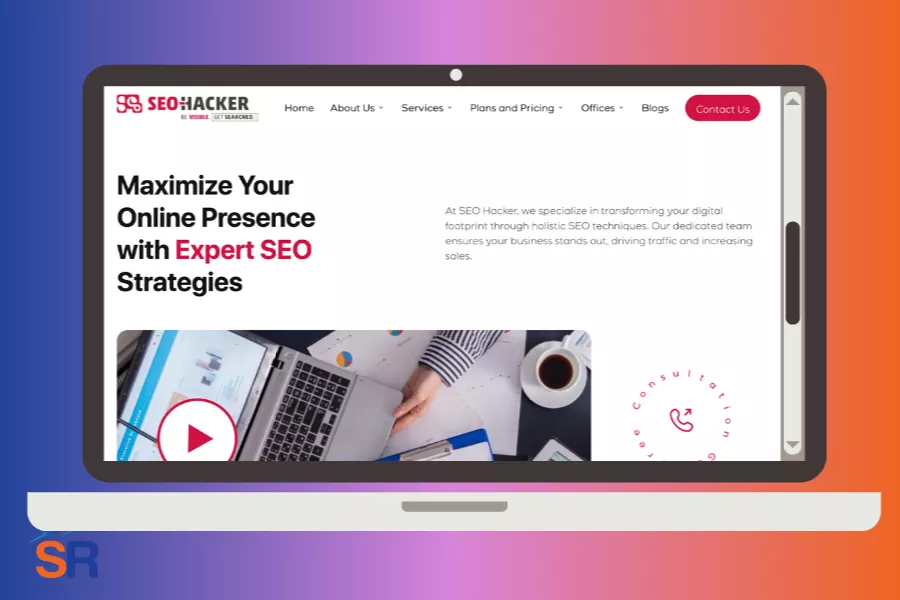
SEO Hacker is one of the earliest SEO companies in the Philippines. With a strong focus on local SEO, they help Philippine businesses appear in relevant local searches and Google Maps listings. Their strategies are ideal for companies that want to dominate in regional search.
SEO Hacker focuses on helping Philippine businesses rank locally and improve their presence in geo-specific searches. The agency provides hands-on SEO services that include local keyword targeting, Google Business Profile optimization, and on-page improvements aligned with local search intent.
5. GrowthRocket
Best for: eCommerce SEO
Industries: Medium to Large-scale eCommerce brands
Strengths: Data-driven eCommerce strategy and execution (SEO, web development, content marketing, email marketing)
Recognizable clients: Booky, Storehub, Tenderbites,
Headquartered in Mandaluyong City, Philippines
Founded by: Houman Akhavan
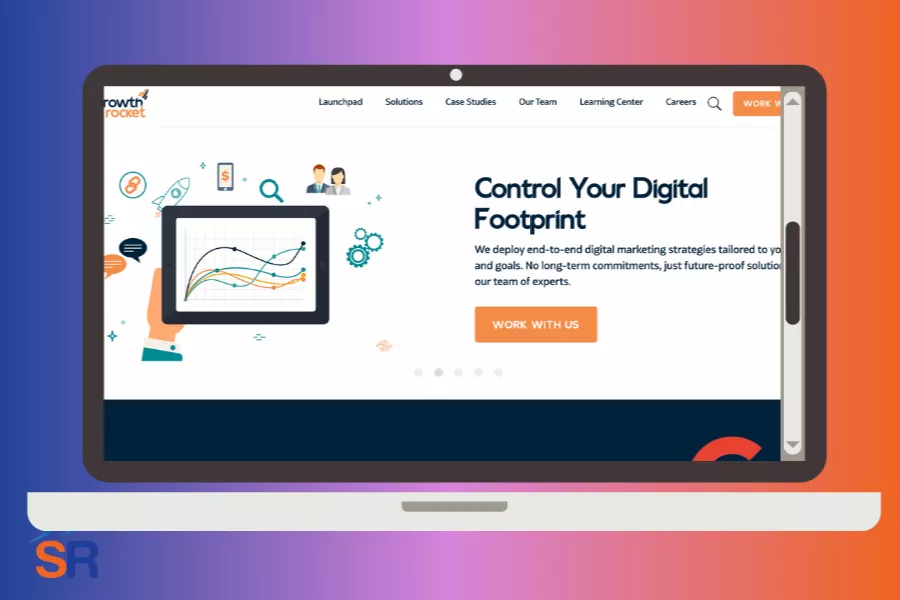
Growth Rocket combines eCommerce SEO with content marketing, email, and web development. Their data-driven approach supports eCommerce brands in scaling search visibility and conversion through technical excellence and brilliant execution.
Their well-integrated process is perfect for medium to large-scale online retailers that want consistent performance improvements across product pages, category pages, and long-tail content.
6. Propelrr
Best for: Data-driven Digital Marketing
Industries: B2B, B2C
Strengths: Data-driven digital marketing that translates deep audience research into actual insights and execution
Recognizable clients: Sanicare, Unionbank, The North Face
Headquartered in Makati City, Philippines
Founded by: Gary Viray
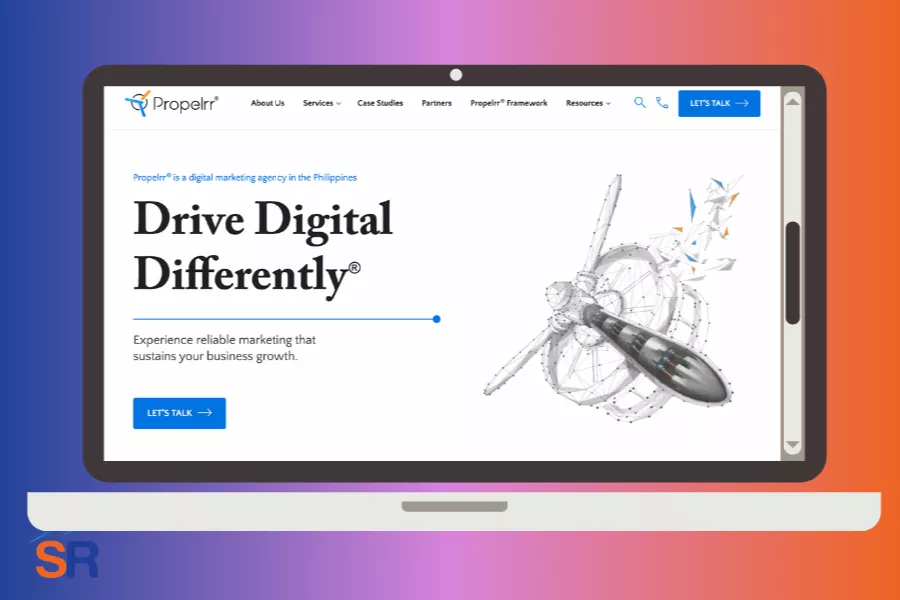
Propelrr builds data-based SEO strategies. They prioritize audience research, behavior analysis, and user intent, turning insights into actions that improve rankings, conversions, and digital growth for enterprise clients.
Propelrr has worked with major brands such as Sanicare and UnionBank, showing their ability to manage large accounts and translate insights into execution. Businesses seeking measurable growth through data-driven SEO will benefit from Propelrr's holistic, research-based methods.
7. Spiralytics
Best for: Content Marketing
Industries: B2B, B2C
Strengths: Creating and promoting content that ranks and converts visitors into actual customers, SEO strategy
Recognizable clients: Globe, Ayala Malls
Headquartered in Makati City, Philippines
Founded by: Jimmy Cassells
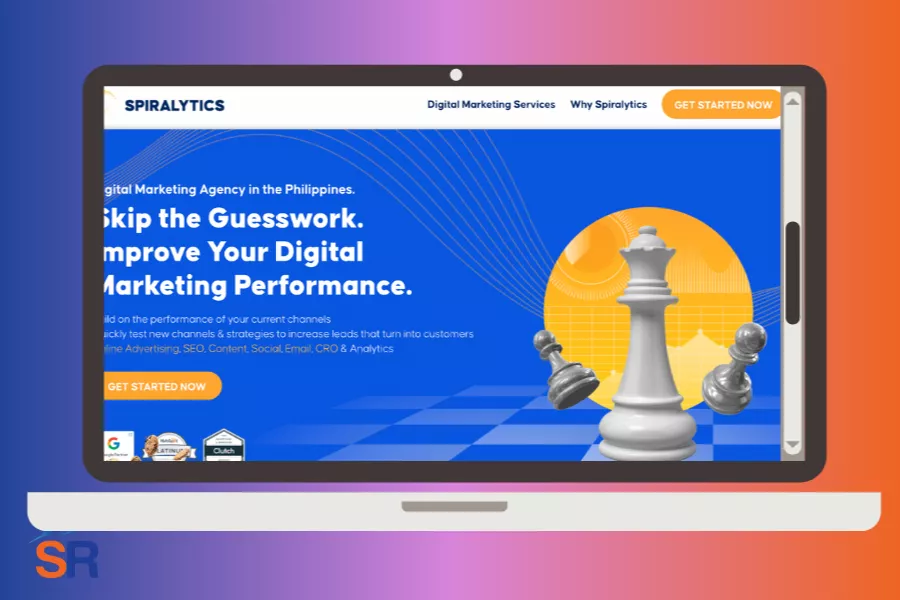
Spiralytics focuses on content marketing as the core of its SEO services. Its strength lies in creating high-quality content that attracts, ranks, and converts. It supports this with technical SEO and data analysis for measurable business results.
Is the SEO Company in the Philippines Legit or Not? (How to Tell)
It's a good question, especially if you're trying to outsource SEO work to a reliable agency in the Philippines. The wrong choice can waste your budget—or worse, damage your website with penalties or your agency's reputation as the one servicing your clients.
That's why it's important to spot which SEO companies in the Philippines are legit and which are not. Below are five clear signs to help you confidently evaluate an SEO agency before signing any contract.
Prefer Agencies Registered as a Legal Business in the Philippines
Many SEO specialists in the Philippines operate as freelancers, and some are skilled at their work—no doubt. However, there's a big difference between hiring a solo freelancer and working with a registered SEO business.
A legally registered company, whether a sole proprietorship or corporation, is easier to hold accountable. They operate under business permits, pay taxes, and often follow structured processes, contracts, and timelines. So, you get added security and initial trust simply by knowing they work under the local authority in the Philippines.
This is especially true for long-term or large-scale projects when you're dealing with a real business entity and not just someone working behind a Facebook page or email address.
You can often check their business name on the Department of Trade and Industry (DTI) or Securities and Exchange Commission (SEC) database to see if the SEO agency registered their business.
Many agencies also include their business registration number or office address on their website or contracts. If an agency avoids sharing legal business details or only accepts informal payment channels, that's a sign to dig deeper before committing or even proceeding to the next steps.
Clear Website and Services
Legit companies have professional websites that clearly explain what they do. It's a crack in their reputation if they don't have any, given that someone optimizing clients' websites must have their own brand working well enough. It not only proves that what they preach is actually working, but it also helps legitimize their services (on top of their legitimate business permits)
Professional SEO companies in the Philippines will have their services broken down into specific solutions on their website, including link building, technical SEO, on-page SEO, and local SEO services. These individual pages will give you a sense of how they work, what tools they use, and what outcomes you can expect as a potential client.
They don't hide behind jargon or vague promises like "boost traffic" without showing you how or giving you actual proof or case studies. If a website is messy, incomplete, or lacks service pages, it likely reflects how disorganized or undeveloped the agency's actual process is.
Real Case Studies or Client Logos
This tip is related to the above-mentioned tip on professional SEO agencies having clear websites and services.
Reputable SEO agencies don't just talk. They show results. They publish case studies to support their claims, explaining how they solved a client's problems and challenges, what steps they took, and the results they achieved in rankings, traffic, and conversions from organic search.
Even when they cannot name the client, especially if they're working under non-disclosure agreements, they can show the client's industry and actual measurable outcomes.
Look for recognizable brands on their clients' lists. If you see Fortune 500 companies like Shopify or conglomerate companies in the Philippines like Ayala Group or Robinsons Group, trust them, that's a clear sign the agency can deliver real SEO work at scale.
Transparent Reporting and Process
The best SEO agencies in the Philippines share their processes upfront. Even if they're not too detailed, they'll show you how they would attack their SEO strategy for your website. They provide a clear roadmap for your campaign, starting with website audits and keyword research and ending with content optimization and link building.
You should know what's happening at each stage of optimization and when to expect results (realistically). Agencies that avoid detailed reporting often don't track actual performance or don't want you to see it. They also share sample reports or dashboards showing keyword positions, traffic increase, live backlinks, and conversion increase from organic search.
Online Presence and Rankings
Beyond having their own websites, reputable SEO agencies you can trust are ones that practice what they preach. A legitimate SEO company should rank for SEO-related keywords in its target market or at least show visibility through guest posts, podcast appearances, or conference talks (e.g., MORCon and PeepCon).
Of course, they may not consistently rank #1 for "SEO Philippines", but they should have a consistent online presence and a strong domain profile. Look them up using tools like Ahrefs or SEMRush to check their agency's backlink profile and brand authority. If they promise SEO results but have no visibility of their own, that's a major red flag.
Named Founders or Team Members
Great Filipino SEO agencies are proud of their people, especially as to how Filipino employers treat their employees. You should find clear information about the founder, leadership team, or at least the lead SEO strategist. These individuals often have LinkedIn profiles, published content on the website's blog or other reputable publications, or speaking engagements, either local or international events that show expertise.
When the people behind the company are visible and verifiable, there's a layer of accountability. If the agency hides who runs it or uses only generic names with no public presence, that's often a sign of a fly-by-night operation.
Ask Referrals From Your Network
Direct referrals are one of the most reliable ways to find a trusted SEO agency. You can't deny the fact that when someone you trust gives you names, it adds initial trust in the person or agency. It warms up the deal.
If someone in your network has worked with an agency on a real SEO campaign, whether for content, link building, or technical SEO work, their feedback carries more weight than any online review.
You get an honest insight into how the agency communicates, delivers, and meets expectations. Referrals often lead to partnerships with agencies (and we had a fair share of this experience in our SEO agency, SharpRocket). Several clients refer us to their networks, given that we've done great work for their existing websites.
This kind of referral reduces guesswork as you search for and vet Filipino SEO agencies properly and actually gives you a head start with a partner that's already proven to deliver.
Access Top-Tier SEO and Link Building Services With SharpRocket
Achieving real organic growth starts with finding the best SEO agency that understands how to drive results through customized SEO strategies. SharpRocket offers SEO services and is highly specialized in link building services built around your brand's needs.
Whether you aim to rank competitive keywords for specific landing pages or strengthen your site's brand authority through link building, SharpRocekt provides the expertise and tools to make it happen.
Ready to scale your search visiblity? Check out our link building and SEO services today.
SEO Pricing in the Philippines: Costs, Factors & What to Expect
How Much Does SEO Cost in the Philippines in 2025?
On average, quality SEO in the Philippines costs ₱50,000 to ₱500,000+ per month, with an hourly rate ranging from ₱3,000 to ₱10,000. The exact cost depends on the SEO provider's expertise, competition level, and scope of services.
- Small businesses: ₱15,000–₱100,000/month
- Mid-sized businesses: ₱100,000–₱150,000/month
- Enterprise SEO: ₱150,000–₱500,000+/month
- Local SEO: ₱50,000–₱150,000/month
For one-time project-based SEO, pricing varies based on specific needs like technical audits, content strategy, or link building, usually ranging from ₱50,000 to ₱200,000 per project.
SEO pricing in the Philippines is totally different from how international SEO agencies charge for their services.
Businesses like yours looking to improve their online visibility must understand what drives SEO costs and the current average SEO package from a reliable SEO agency in the Philippines.
This guide breaks down SEO pricing models, cost factors, and what businesses should expect when investing in SEO in the Philippines.
Whether you're a small business, a marketing agency trying to outsource white-label SEO, or a large enterprise with an existing in-house SEO team, knowing what you're paying for helps you maximize your SEO investment.
SEO Pricing Models in the Philippines
SEO services in the Philippines come in different pricing structures, allowing clients to choose a model that fits their budget, goals, and required level of service.
There are generally four common SEO pricing models: monthly retainers, project-based SEO, hourly consulting, and performance-based SEO. Each has its upsides and is suited to different business needs.
Let's go to each of one of them.
1. Monthly Retainers – Ongoing SEO Services
Monthly retainer SEO is the most popular SEO pricing model.
Optimizing a website requires continuous work, either to reach the top spot in Google's SERPs (#1 for target keywords) or to maintain that position, so getting a monthly retainer is the way to go when hiring a Philippine SEO company as it involves consistent work.
With a monthly retainer, clients pay a fixed monthly fee for ongoing SEO work. This helps the website stay optimized to further adapt to Google's algorithm changes and changing search landscape and features for every target keyword, making the website remain competitive in Google's search results.
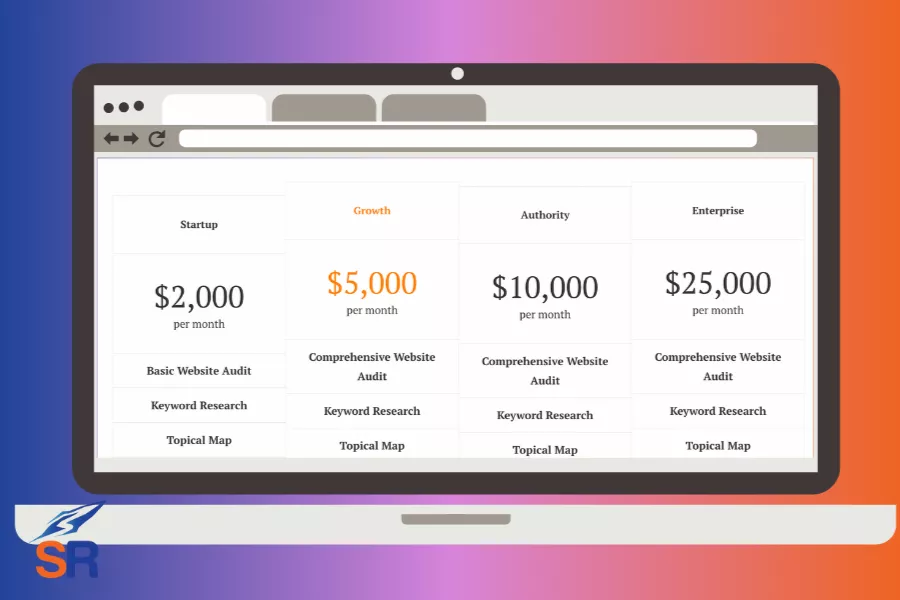
Why Choose a Monthly Retainer For SEO?
SEO takes time—ranking improvements don't happen overnight. The average time it takes to rank a website is 3 to 6 months, and that's for fairly good websites with low to medium competition.
Competitors are also investing in SEO—so you're not the only one interested in ranking for your target keyword. Even if your website ranks well today, there's no guarantee you can maintain it tomorrow. Competitors may outrank you if they implement better SEO strategies. Having regular updates to your content and link building, and doing it consistently helps maintain ranking positions.
Google's algorithm updates affect rankings—and they will always do so, given they constantly want to improve search results to satisfy users' intent and needs. Without ongoing SEO adjustments to adjust to what they want to appear on SERPs, your website rankings can drop unexpectedly.
Topping it off, SEO is more than just rankings—the website traffic you get from search must convert into actual customers. So, if SEO is giving you a constant number of leads every month, it's wiser to invest more in it to maximize its returns.
What's Included in a Monthly SEO Retainer?
A monthly SEO retainer supposedly must cover all essential aspects needed to improve and maintain your website's rankings. So, if you're researching reputable SEO agencies, see the inclusions of SEO packages.
Here's what is typically included in a monthly SEO retainer:
- Technical SEO—optimizing the website's infrastructure, sending signals, and allowing Google and other search engines to crawl, index, and rank pages effectively. It covers site speed optimization for faster website loading times, mobile-friendliness, implementing structured data and schema markup, cleaning codes for better crawlability, and properly managing indexed pages (canonicalization, robots.txt, XML sitemaps).
- On-page SEO improves a page's content and code to increase topical relevance and searchability. The process involves meta optimization (title, description for CTR improvements, H1, H2s, etc.), image optimization, and internal linking to improve search engine crawling and send rich signals to Google about your page's content.
- Content Development—creating helpful content that addresses the search needs of your target audience, which heavily involves writing engaging blog posts that satisfy what the searchers' want while optimizing it to increase the likelihood it'd rank for its target keyword, updating and refreshing content for continued relevance, and seeing through analytics to improve underperforming content to build up their rankings further.
- Link building—building relevant, quality backlinks from publications and websites to pass more link juice to your destination pages, increasing their ranking power for their target keywords. It also helps improve the website's crawlability and build its topical authority within the niche.
- Analytics and Ongoing Improvements—continuous monitoring analysis to refine SEO efforts by finding pages to improve their satisfaction with user intent and needs, running regular SEO audits to close technical and content gaps (against competitors), and enhancing conversions by optimizing pages for lead generation.
Who Should Choose a Monthly SEO Retainer?
The short answer is every type of business. As mentioned earlier, SEO work is an ongoing process, and as long as your target audience is constantly searching for possible solutions for their problems and needs, you should continue optimizing your website to capture these customers.
What is the Monthly Cost for SEO in the Philippines?
The monthly cost for SEO ranges from ₱50,000 to ₱500,000+ in the Philippines. The exact pricing depends on the scope of work, competition, and the SEO provider's expertise.
2. Project-Based SEO – One-Time Optimization
Project-based SEO is a one-time payment model where businesses pay for a specific SEO service. This applies to companies who have already started their SEO and may need to fix an SEO issue or get consulting advice to remove hurdles with their current SEO activities without actually committing to a long-term contract.
Generally, you'll find more in-house SEOs working for companies to opt for project-based SEO, as they already have existing SEO systems in place and would need an external eye to see through further optimization of websites they're currently working on.
Here are examples of project-based SEO:
- One-time SEO audits (technical SEO, on-page SEO, and content optimization)
- Local SEO setup (setting up Google Business Profile and schema implementation)
- Content strategy development (creating topical maps, content briefs for top keywords to target, and/or developing an editorial calendar).
- Link building (a couple of links built to the most important landing pages, usually commercial pages, to rank for transactional keywords).
3. Hourly SEO Consulting – Pay Per Hour for Expert Advice
Hourly SEO consulting is ideal for clients who need expert insights and strategic direction but don't require a full-service SEO campaign. A consulting type of SEO work is a more flexible and cost-effective option for those who currently handle SEO in-house but need professional guidance on certain matters of optimization.
So, what can be covered in an hourly consultation? Here are what you might need in the future:
- SEO strategy development
- Competitor and keyword analysis
- Website performance audits
- Technical SEO troubleshooting
- Content strategy recommendations
- Link building strategies
For example, SharpRocket's CEO, Venchito Tampon, is a top SEO consultant who specializes in link building and content development and helps SEO agencies and in-house SEO teams streamline their link building operations.
Other Filipino SEO consultants could help with the overall SEO campaign, from technical SEO to content strategy, which is another advantage if you want a full spectrum of consulting advice.
With hourly SEO consulting as the SEO pricing model in the Philippines, you only pay for the time (mainly hourly) in exchange for specific advice you need. You can ask as many questions as you can related to the scope of expertise of the SEO consultant.
What is the Cost of SEO Consulting in the Philippines?
The cost for SEO consulting in the Philippines ranges from ₱3,000 to ₱100,000, depending on the consultant's expertise, consultation scope, and service duration.
4. Performance-Based SEO – Pay Only For Results
Performance-based SEO pricing allows in-house SEO teams and business owners to pay only when specific results (or KPIs) are achieved.
While it may seem like a cost-effective option, it is a less common SEO pricing model, given the many factors that come into play.
However, you'll find that performance-based SEO works well for venture capitalists hiring SEO experts to join their companies, giving them a share of profit in exchange for results. That's where performance-based SEO comes in.
Performance-based SEO has more dynamic pricing structures compared to monthly retainers, hourly rates, and project-based SEO. The price is determined based on the agreement between the person asking for SEO work and the person servicing it.
What is the Cost of Performance-Based SEO in the Philippines?
The cost for performance-based SEO in the Philippines starts at ₱50,000+, but the final price depends on factors like competition, target keywords, and agreed-upon results. Unlike fixed-fee SEO models, performance-based SEO charges only when specific goals are met, such as ranking improvements or traffic increases.
Cheap SEO vs. Quality SEO: What to Choose?
Budget is a big consideration when choosing the right SEO provider in the Philippines. As a client, choosing between cheap SEO and quality SEO is a critical decision. While it's tempting to choose low-cost SEO, as it appears attractive within your current budget, it often leads to short-term gains, poor execution, and, worst of all, long-term damage to your brand.
Conversely, high-quality SEO services prioritize long-term rankings (sustainable if possible), organic traffic growth, organic revenue, and stronger brand authority.
The Risks of Cheap SEO
Cheap SEO services often cut corners to lower costs. You usually find these even in small Filipino SEO agencies and freelancers. Here's why opting for low-cost SEO can hurt your business:
1. Black-Hat SEO Techniques That Can Get You Penalized
Many cheap SEO providers use shady, aggressive tactics such as keyword stuffing and link farming (with Private Blog Networks) that result in manual penalties or low to no effect on website rankings.
It's a complete waste of time if you understand the strategy itself, where most of their time and resources are spent trying to manipulate search rankings.
2. Poor Content That Fails to Engage Users
Google prioritizes helpful content that satisfies user intent. With cheap SEO services, you resort to seeing low-value, sometimes AI-generated or duplicated content that neither ranks well nor engages visitors.
In the age of AI, you'll see scrupulous SEO freelancers spinning content without human edits that only struggle to rank for their individual target keywords and fail to convert visitors (if there are any) into customers due to a lack of original gain, credibility, and actual value to users.
3. Spammy Link Building That Hurts Rankings
Relevant, quality backlinks from reputable websites are a strong ranking factor. Cheap SEO providers may purchase bulk backlinks from generic, PBN-like websites that don't contribute much to building brand value and strengthening your link profile to compete well with your competitors.
If you see link building services ranging from $10 to $50 per backlink, be curious as to why they sell at such absurdly low prices. Either the links come from submission-based directories or from ad-heavy and low-performing PBN blogs.
4. Lack of Strategic Planning & Personalization
SEO is not one-size-fits-all, as each business needs a unique approach to targeting different audiences with engaging content and determining the right keywords to capture traffic that makes sense to the business.
It's easy to dive into any keyword research tool and see a high-volume industry keyword, but if it doesn't align with business goals—meaning it is not relevant to the business and is unlikely to convert visitors into customers—it's a waste of time to hire cheap SEO services that do this.
5. No Transparency & Poor Reporting
A reputable SEO provider in the Philippines should offer clear reports on rankings, traffic, and organic revenue growth. An SEO client only cares about these numbers.
Cheap SEO services often lack transparency and only report on mere deliverables, such as five on-page optimization tasks for the month or 10 directory links, that leave SEO clients uncertain about what's actually being done in line with the business revenue goals.
Why Quality SEO is a Better Investment
If you're not yet convinced, here's why quality SEO really works. It may require a higher upfront investment, but it could deliver long-term sustainable results with 15 to 30X returns on investment, at most.
1. Fundamental SEO for Sustainable Growth
By following the best practices for optimizing your website, you can expect a solid foundation for gaining search traffic over time, not just rankings.
A professional SEO company's strategies compound month over month. That includes securing links from reputable sources, researching topics (not only keywords) to rank for multiple variations of keywords within topic clusters, and optimizing websites for better user engagement and satisfaction.
You don't usually see these types of SEO strategies with cheap SEO providers, as they only resort to shortcuts in gaming the system.
2. Strategic, Data-Driven Approach
SEO is both an art and a science. The science involves analyzing industry trends, benchmarking competitors, and refining your current strategy based on data.
With analytics and improvements, high-quality Filipino SEO services can leverage their existing work (content, links, and website) to gain more search traffic with optimal efforts and resources.
3. Helpful Content To Rank and That Builds Topical Authority
Content creation and promotion require investment, and so, with quality SEO agencies working with you, you would expect helpful, well-written content that not only satisfies user intent but also aligns with your brand's voice and style.
From ideation to promotion, it takes legwork and constant pruning to increase the website's organic growth, not only with the volume of content churning out by your team but with the quality ones you're publishing on your website.
4. Safe & Effective Link Building
Professional SEO providers in the Philippines understand the true essence of link building. Through the quality of backlinks, they aim to increase a website's trust, relevance, and authority.
With that, taking the toil for every phase of link building is what every SEO needs (and what the client expects from a reputable SEO agency). Links should be done in hard work, either by creating linkable content assets to attract links naturally or by doing consistent manual outreach to get link placements on relevant, trusted websites.
Effective link building is becoming the main differentiator between the best SEO providers in the Philippines and the cheap SEO services provided by freelancers.
How to Choose the Right SEO Provider in the Philippines? (Beyond the Basics)
Finding the right SEO provider in the Philippines can mean the difference between sustained online growth and wasted investment. Many clients get frustrated with SEO agencies as they jump from one to another, seeking a reliable service provider who can demonstrate real work and results.
Many businesses still rely on common criteria like past results, transparency, and avoiding false promises, but these are just the basics. To make you hire an SEO agency that rarely delivers business value, go beyond the standard vetting, and look for strategic, forward-thinking qualities.
Here's how to actively assess and choose the best Filipino SEO provider:
1. Look for an SEO Framework, Not Just a List of Tactics
Many SEO providers will offer you a list of services (e.g., keyword research, link building prospecting lists, technical SEO checklist, etc..), but what you really need is a strategic framework (a simple one) that ties everything together.
So, when searching for a reliable SEO provider in the Philippines, find one that can give you a simplified SEO roadmap. A good SEO agency should provide you with a clear, step-by-step strategy that explains how SEO would align with your business growth goals over time.
Of course, you won't see a 100% perfect framework, but a deep expert in their craft knows how to communicate it with their clients early on in their discovery calls.
You can also check if they prioritize SEO fundamentals before advanced tactics. As someone says, " You can only go advanced if you master the basics." That's very true for SEO, as you need to first fix your site's foundation (technical SEO, site architecture, content quality, etc.) before scaling link building or other off-page SEO tactics.
Look for their case studies and how well they want to try to understand your industry and competitive landscape. Do they ask questions about your list of competitors, target keywords, and historical data to simply your site's current benchmark in SEO? All these are necessary for a good SEO company to craft a customized SEO roadmap that is more likely to succeed than one that offers a cookie-cutter package.
2. Focus on SEO ROI, Not Just Rankings
SEO isn't just about getting to the first page of Google. It should drive measurable business outcomes like organic revenue growth.
Even if you have tens of thousands of traffic, but if they don't convert them into actual customers, as this traffic is generic enough and not relevant to your business, it won't matter from a business revenue perspective.
The best SEO providers in the Philippines don't just track traffic and keyword rankings; they also track organic revenue growth, return on investment (ROI) from organic search, and brand search volume (is there an increasing number of people searching for the brand?).
You can also check if these SEO agencies integrate SEO with conversation rate optimization (CRO). Someone whose concern is to generate more business will help optimize landing pages and call-to-actions and add phone numbers and inquiry forms to ensure any relevant SEO traffic converts into business leads.
3. Evaluate Their Ability to Compete in Competitive Niches
If you operate in a competitive industry like YMYL (Your Money Your Life) industries, where Google is highly operative on the quality of content being published for related topics that would either improve or damage someone's life or maybe in other industries such as legal, the agency's SEO strategy needs more than just basic optimizations.
Given that your competitors are also doing fundamental SEO, finding SEO gaps that they don't overlook can help you outrank them for your target keywords.
You may also ask for some advanced SEO tactics such as topical authority-building (creating clusters of content around core topics to dominate search results), creating researched-backed content that earns natural backlinks from A-tier publications, or doing more digital PR and link building partnerships to secure links from credible media outlets.
During your discovery call with them, you can discern if the person you're talking to knows what their agency is saying (and walking as proof of their results). The better they can communicate with you how they would attack their SEO strategy for your specific website, the more you should consider them your preferred SEO agency.
4. Choose an SEO Provider That Goes Beyond Blogging
Many SEO agencies overfocus on blogging, and some do it only to include mere deliverables in SEO reports.
But the true essence of building is to impact your site's topical authority so that Google sees you as a go-to solution or expert in your industry via publishing resources that really serve the intent of their searching on Google in the first place.
The blogger strategy of professional SEO agencies, particularly in the local scene, includes optimizing content for search intent, conversions (for commercial intent), and user engagement. A balance of all these three determines whether a page is highly valuable and could really impact the overall SEO strategy.
5. Work with an SEO Provider That Educates & Empowers Your Team
SEO isn't just about hiring an agency and letting them work in isolation. In many cases, SEO agencies partner with your company's in-house SEO teams to brainstorm strategies and develop better decisions in the long term.
The best founders of SEO agencies act like consultants. They provide recommendations for the improvements of the website from an SEO and conversion perspective while giving you the freedom to decide what works best for you.
You don't treat them as employees where you need updates every hour of the week, but you ensure you're satisfied through the quality of their SEO work and constant communication when the need arises.
One red flag to look at SEO agencies is when they keep their process secretive and don't explain their work for your website, as more often than not, they may be using methods that could harm your rankings instead of improving them.
Factors That Influence SEO Costs in the Philippines
SEO pricing in the Philippines considers multiple factors, from service scope and market competition level to website complexity and SEO provider expertise. Like any other B2B service, you should understand what drives costs to make better decisions and allocate your marketing budgets wisely.
Here's a detailed breakdown of the factors that influence SEO pricing and hidden insights many companies overlook.
1. Scope of SEO Services
The pricing must reflect the scope of SEO initiatives required to fulfill the need.
For instance, basic SEO that costs around ₱50,000 to ₱100,000/month would typically entail:
- Technical audit and basic site optimization
- Metadata and on-page keyword optimization
- Google Business Profile setup (for local SEO)
- Simple backlink strategy (guest posts, niche blog outreach)
While a more advanced SEO package has more comprehensive approaches that range from ₱100,000 to ₱500,000+/month. It normally includes:
- Comprehensive keyword research and competitive analysis
- Full-scale content marketing and long-form content production
- Enterprise-level technical SEO (site structure, schema markup, speed optimization)
- Consistent and effective link building, acquiring editorial and high-authority backlinks (with digital PR)
Some SEO agencies bundle PPC (Pay-Per-Click) advertising (another sub-discipline of digital marketing) into their SEO packages, which would increase their SEO pricing but would provide you a much better guarantee of lead generation, both of which are intent-based marketing disciplines.
2. Website Size and Complexity
The size and complexity of a website directly impact SEO costs because large websites (with 100,000< pages, for instance) or established brands of conglomerates in the Philippines may require more strategic content, technical optimizations, and a structured way of doing link-building.
For instance, you would see higher-cost packages for eCommerce brands with, let's say, 500+ product pages, ranging from ₱150,000 to ₱500,000+/month. The larger the website and more popular the company is, the higher SEO agencies charge for their services.
3. Keyword Competition
Not all keywords cost the same to rank for. Competitive, high-value keywords (like "credit cards Philippines") would require fundamental and strategic SEO efforts, making the SEO pricing for websites ranking for those keywords more expensive.
The lower the competition level for keyword, the more likely you can negotiate for affordable SEO prices. However, that's not guaranteed, as most premium SEO agencies base their cost model on value-based pricing. This means that if they can generate leads consistently for your business, and with given price offers of your products or services, they can charge more reasonably for their SEO services based on that.
Conversely, if you're contesting with highly competitive keywords, be prepared for a higher-cost package from SEO agencies. As the keyword gives you the business breakthrough in direct high-ticket leads, the cost of SEO services would be much higher.
The fundamental reason is that the more competitive the keyword, the more work is involved in optimizing the website. This means more helpful content must be published regularly, and the higher number of high-quality backlinks must be consistent every month to ensure the client's website's ranking potential is built up.
4. Local vs. International SEO – Expanding Beyond the Philippines
Most local businesses in the Philippines prioritize local search, especially if they only serve customers within a specific geographical area. As such, they could expect a lower SEO package, as the local or city-based search landscape here in the Philippines isn't quite competitive compared to national SEO searches ("keyword" + Philippines).
So if you want to optimize your website for local SEO, the cost of SEO services ranges from ₱50,000 to ₱150,000/month), while if you're going to take to international level, which means you want to target multi-country searches, the cost for international SEO ranges from ₱200,000 to ₱500,000/month.
If you're looking for white-label SEO services, you may be expecting an affordable option from Philippine-based SEO agencies. The cost for white-label SEO services ranges from ₱50,000 to ₱200,000+/month. This is one-third of what you'll be paying for counterpart agencies in Western countries.
5. Agency vs. Freelancer Pricing – The Cost of Expertise and Resources
Hiring an SEO agency costs more than working with a freelancer, given that SEO agencies entail more costs in operations to ensure quality output. Office overhead, hiring, and staffing costs would add up to the cost of SEO services, increasing SEO pricing.
Agencies provide more full-scale services that freelancers may not offer or have limited capacity to do so.
That's why an experienced SEO agency in the Philippines will likely charge 2x-5x more than a freelancer, but you would expect to have higher-quality, scalable SEO campaigns.
6. Link Building Strategy – Cheap Links vs. High-Authority Links
If you're looking to hire a Philippine SEO agency, the package should include link building services.
Backlink quality directly influences SEO costs. The better quality of backlinks you want, the higher the cost for agencies. They usually do more than legwork in prospecting, content creation, and manual outreach to secure link placements to beat the competition, helping your website rank higher with a stronger backlink profile.
That's why you can't resort to cheap SEO services, as most of the time, they use cheap link building work that doesn't impact SEO results.
With professional SEO agencies, you're likely to see premium-quality work for link development, which fundamentally affects your website's ability to grow faster in search.
FAQs
How much does an SEO freelancer make in the Philippines?
SEO freelancers in the Philippines can charge anywhere from ₱3,000 to ₱100,000 per consultation session, depending on their expertise, project complexity, and client requirements.
How to calculate SEO cost?
SEO costs are calculated based on several factors, including:
- Scope of Services (technical SEO, content, link building)
- Website Size & Complexity (small business vs. enterprise SEO)
- Keyword Competition (high-value keywords require more work)
- SEO Pricing Model (monthly retainer, hourly consulting, project-based, or performance-based SEO)
Why is SEO so expensive?
SEO is expensive because it requires continuous optimization, high-quality content creation, strategic link building, and adapting to Google's algorithm changes. It is a long-term investment that delivers sustainable organic traffic and conversions.
How to charge for SEO services?
SEO services can be charged using different models:
- Monthly Retainer (₱50,000–₱500,000+)
- Project-Based (one-time fee for audits or setup)
- Hourly Consulting (₱3,000–₱100,000 per session)
- Performance-Based (payment based on results)
Is SEO worth it for small businesses?
Yes, SEO is worth it for small businesses as it helps them rank higher on Google, attract organic traffic, and generate leads without relying on paid ads.
Is SEO marketing free?
SEO itself is free, but effective SEO requires investment in content creation, technical optimizations, and link building, which makes it a paid service.
Do you need a budget for SEO?
Yes, SEO requires a budget for technical improvements, content creation, and link building. Quality SEO services range from ₱50,000 to ₱500,000+ per month.
How much does an SEO lead make in the Philippines?
An SEO Lead in the Philippines typically earns an average annual salary of approximately ₱744,000. This figure can vary based on factors such as experience, location, and the specific responsibilities of the role.
How much do freelancers charge in the Philippines?
SEO freelancers in the Philippines charge between ₱3,000 to ₱100,000 per session, depending on their experience and the project scope.
Is SEO freelancing profitable?
Yes, SEO freelancing is profitable in the Philippines, especially for skilled professionals who offer high-quality services in content creation, technical SEO, and link building.
Is SEO a monthly fee?
Yes, most SEO agencies charge a monthly retainer fee ranging from ₱50,000 to ₱500,000+ per month, depending on the scope of work.
Is SEO a one-time cost?
SEO is not a one-time cost. While businesses can pay for one-time SEO audits or project-based services, ongoing optimization is needed for long-term ranking success.
Is SEO worth it?
Yes, SEO is worth it because it drives organic traffic, builds brand authority, and increases conversions. High-quality SEO can provide long-term growth and return on investment.
SEO For Mass Tort Lawyers [Using First to Rank Approach]
Mass tort lawyer SEO demands a "first-to-rank" approach, given there's a need to rank quickly before the case intake period closes.
The urgency of optimizing pages comes from the idea that most mass tort lawsuits emerge due to breaking news, product recalls, or legal actions. This means the first few law firms to rank get the majority of leads.
If you want your law firm to be the first to capture these qualified leads before they pass, this guide will show you unique SEO strategies for your mass tort legal service.
What is Mass Tort Lawyer SEO?
Mass tort lawyer SEO is the specialized practice of optimizing mass tort law websites using a "first-to-rank" strategy, rapid content development, and authority link building to ensure your law firm ranks quickly for emerging mass tort cases.
Unlike general legal SEO, mast tort SEO focuses on high-volume, high-stake cases involving multiple plaintiffs against large corporations, such as pharmaceutical companies, medical device manufacturers, and product liability claims.
SEO Strategies for Mass Tort Lawyers
In this guide, let's dive into what makes your mass tort law service generate qualified leads monthly.
"First to Rank" SEO: Speed-Based Content Deployment
Given that mass tort cases have a limited window for claimants to file, being first to establish online visibility, primarily your ability to rank quickly, can mean securing the highest volume of potential clients before the competition intensifies.
Unlike general SEO or legal SEO, where you want to rank for every local city possible, searchers behave differently with mass tort law cases. It's similar to how you do SEO for publishers (or newspapers), where you are ready to churn out content pieces as soon as opportunities arise.
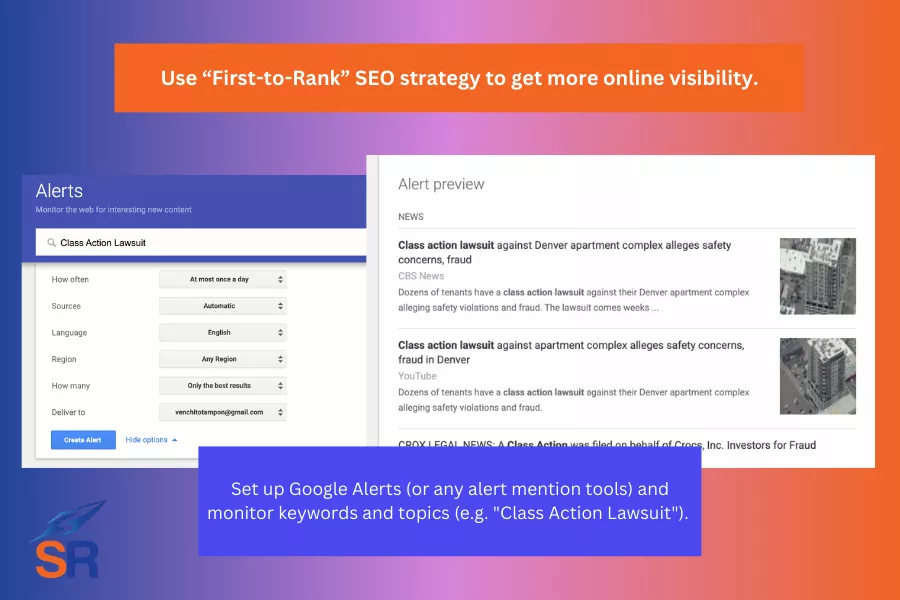
Here are a couple of ways to implement a "first-to-rank" SEO strategy for your mass tort law practice.
Set up Google Alerts and Legal News Monitoring
Diving into breaking news and possible mass tort legal cases requires setting up systems as soon as the clamor hits.
Start setting up Google Alerts (or any alert mention tools) and monitor keywords and topics like the following:
- "Class Action Lawsuit", "Mass Tort Update", or specific drugs/products.
- FDA recall updates to track newly recalled drugs or defective medical devices that may lead to litigation
- PACER (Public Access to Court Electronic Records) for lawsuit filings to detect emerging mass tort cases before they gain mainstream attention.
These actions comprised 50% of the entire content strategy, as you will only create content assets on topics you've monitored.
Publish Pre-Build Mass Tort Landing Pages
The secret to ensuring you're one of the first to capture the case is to create template lawsuit pages before they trend to ensure you can rapidly deploy the content.
Here are actionable tips to help you publish a solid mass tort landing page:
- Develop modular page templates for mass tort cases with placeholders for drug names, product defects, and claim criteria.
- As soon as a lawsuit gains traction, update and publish immediately instead of starting from scratch.
- Prepare draft pages and optimize them with titles that fit the legal case (e.g., "[Medical Device Name] Lawsuit: Do You Qualify?").
- Add sections to landing pages for eligibility, potential payouts, and next legal steps.
- Include evergreen content that can be updated, such as general information on mass tort claims, legal processes, and case timelines. Leave a window for changes to customize every landing page to the need (you don't want duplicate content for landing pages).
Leverage Internal Linking
Internal linking is one of the underrated SEO strategies for most businesses, not only for law firms. It can immensely help your most important pages climb higher in Google's SERPs.
When publishing new lawsuit pages, here are smart ways for internal linking:
- Link internally to relevant practice area pages and previous mass tort content to bolster link juice and ranking abilities.
- Optimize metadata (title tags, headers) with high-intent keywords like "[Product] Lawsuit Settlement", "[Drug] Compensation Claims", and "Do I Qualify for a [Lawsuit Name] Lawsuit?"
- Add FAQ schema markup to send rich signals to Google about your page's content. This helps your page rank in Google's Featured Snippets.
With internal linking, you encourage users to visit more relevant pages and convert them into actual clients by learning what and how your legal service works.
Payout Optimization Content Strategy
The unique search behavior for mass tort law SEO is generally that potential claimants often search for mass tort settlement estimates before contacting a lawyer. They want to understand and know how much compensation they may receive before committing to legal action.
In other words, they want to make sure joining the lawsuit is financially worthwhile, covering legal costs and securing compensation that justifies the effort of filing a claim.
On top of the dedicated landing pages for specific law cases, publish pages that include financial expectations, case comparisons, and real-time updates that convert better because they offer tangible insights into lawsuit outcomes.
You'll find many mass tort search queries for keywords like "average payout for [Law Suit Name]" or "expected settlement for [Case Name] claim".
If your law firm ranks for these queries, you can capture high-intent leads who are ready to take action (increasing the likelihood you're getting qualified leads).
You can apply these actionable tips for payout optimization content strategy:
- To build more initial trust and credibility, create payout estimate pages that include historical settlements, case studies, and payout tables.
- Use structured data (schema markup), so Google recognizes your page as an authoritative source for settlement information.
- Publish comparison content for lawsuits to target searchers evaluating multiple claims by comparing case values (e.g., "Roundup vs. Paraquat Lawsuits: Which Pays More?").
- To maintain rankings, keep payout pages fresh with recent settlement figures and court rulings. If a significant settlement is announced, update your content to reflect the latest amounts and legal precedents. This also sends freshness signals to Google, improving your website's rankings.
- Add relevant case studies or success stories. Highlight past cases where your firm helped plaintiffs secure substantial settlements. Include before-and-after financial impacts (e.g., medical expenses covered, lost wages compensated).
Payout content is a content format that works extremely well for mass tort lawyers, as it addresses the main search intent and needs of your target users ("claimants").
Multi-Channel SEO Amplification Using Organic Social
Google has been extremely biased towards brands, as searchers have more initial trust in these websites (as they do frequent branded searches). With that, more and more companies must heavily invest in creating holistic campaigns to get more referral, social, and directtraffic, in addition to search traffic.
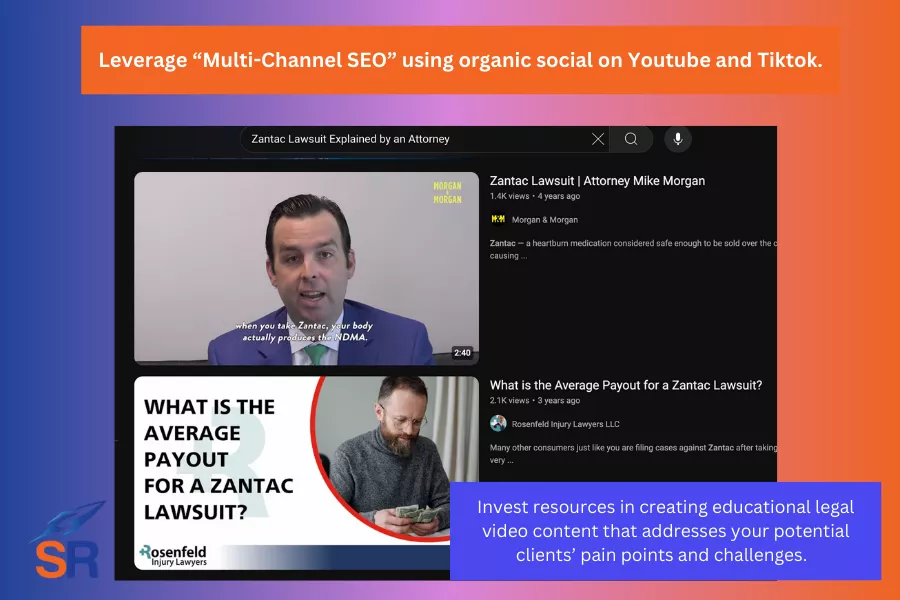
Our SEO company calls it "multi-channel SEO," given that search engine optimization is geared toward generating traffic diversity for your website.
On top of that, you'll see Youtube videos and Reddit threads ranking for legal queries, as users prefer video content and peer-driven (unbiased) advice over traditional law firm directories and websites.
The real reason is that video-based content breaks down complex legal topics into digestible formats, making it easy for people to understand their rights and act.
Upload Lawsuit Explainer Videos to Youtube
Do a Google search for your target keywords and see if they favor video results. If they do, invest resources in creating legal education content. For instance, the topic Zantac Lawsuit Explained by an Attorney (2025 Update) can be well received by claimants, as the video gets more visibility by ranking for the target keywords.
Here are important tips to optimize your YouTube videos:
- Optimize the video with keywords in the title, description, and captions to improve the ranking for both the YouTube platform and organic search listings.
- Use timestamps for key questions like "Who qualifies for a Zantac lawsuit?" or "How much can you receive from a mass tort settlement?"
- Include a call to action (CTA) to encourage viewers to visit your legal service page or call you for a free consultation.
- Use closed captions and subtitles to improve accessibility and ranking potential.
Engage on Reddit and other community websites.
The best way to leverage Reddit is through proper engagement. Here are some tips to help you get started:
- Actively participate in r/legaladvice, r/classactionlawsuits, and Quora threads related to mass torts.
- Answer frequently asked legal questions and link back to your firm's lawsuit guides only if they are relevant.
- Avoid overt self-promotion—instead, focus on providing value and building authority. If you don't include a link, you'll get more branded searches as you include your law firm's name.
- Create TikTok & Instagram Reels on Mass Torts
Interestingly, you'll see tips here on how to leverage social media for traffic acquisition, even if this is an SEO guide for mass tort lawyers. The truth is that more and more people are searching on TikTok, not just on Google.
So, diversifying your search strategies (as you would call it) can help your potential clients find legal cases, especially the younger demographics.
Here are a few actions you can take:
- Upload 30-second reels explaining lawsuits (e.g., "Who Qualifies for a Camp Lejeune Settlement?")
- Use storytelling and real-life examples to connect emotionally with potential claimants.
- Leverage trending sounds and use hashtags to increase video reach (like #MassTortLawsuit, #LegalHelp, and #ClassActionLawsuit).
- Keep videos concise and engaging —hook the viewer in the first 3 seconds.
- Encourage followers to comment with their questions, create organic engagement, and increase post visibility.
By diversifying your content strategy, you will send rich signals to Google that your law firm is a brand and not just another law firm. This will help you get more branded searches and ultimately rank your mass tort legal service pages.
Applied Technical SEO
In our experience, many law firm websites, not just mass tort law firms, have overloaded homepage sliders, auto-play videos, and many unoptimized images, leading to slow load times.
In an attempt to showcase credibility and trust through videos and high-quality images, the website suffers from poor user experience and lower search rankings.
Here's how to implement basic technical SEO for your mass tort lawyer's website:
- Identify slow-loading elements using Google PageSpeed Insights and fix code bloating and issues you'll find using the tool.
- Optimize images by converting them to WebP format (or, better yet, upload images that already have this format), reducing file sizes without compromising quality.
- Enable lazy loading for images and videos, ensuring they load only when users scroll to them.
- Minimize JavaScript and CSS blocking issues by deferring unnecessary scripts.
- Eliminate excessive redirects and delete outdated plugins (for WordPress websites) that only slow down performance.
- Implement the correct schema markup for lawsuit pages (FAQ, Event schema, etc..) to help Google better understand your pages and rank them better.
- Smart internal linking across your pages can avoid orphan pages (pages with no internal links). Distribute link equity to the most legal pages to help them increase their page authority.
- Make your website mobile-friendly—this is not optional, as most users today search for legal help on their mobile devices. You can test mobile usability using Google's Mobile-Friendly Test to identify these issues.
- Use Google Search Console to check for indexing errors, duplicates, and coverage pages. There are case-to-case basis actions for each of these pages, but here are a couple of technical SEO guides to help you.
Your action plans will be based on your site's technical SEO issues. Set a priority list, sort recommendations, and take action steps from lowest to highest impact on your site's search performance.
Strategic Link Building
In a competitive space like legal, link building must be an integral part of your SEO campaign. Not only does it give your website ranking power to push up your service pages, but it also helps search engines improve your site's crawl rate, helping your new pages be indexed quickly on Google.
Unlike other law firm SEO strategies, such as real estate, bankruptcy, and immigration, mass tort link building requires a targeted approach based on local relevance and trusted and authoritative link sources.
Here are proven and tested link building strategies for mass tort lawyers:
- Get listed in legal directories such as Justia, Avvo, Nolo, HG.org, and Martindale-Hubbell—only invest in trusted ones.
- Claim and complete your law firm's profile on bar association websites (particularly the ones you belong to).
- Pitch local journalists for expert commentary opportunities (provide legal guidance on the inputs they need for their content work).
- Publish data-driven content to attract local press coverage (e.g., "Mass Tort Lawsuit Deadlines in California"), which can help attract regional backlinks.
- Sponsor local events, charities, and legal workshops to earn event-page backlinks that are hard to replicate by your local competitors.
- If you've been invited to speak at corporate, local, and school events, see if their websites have dedicated pages to get backlinks back to your firm's website.
There are many ways to get high-quality backlinks to your mass tort law website, but the above strategies are enough to give you a head start.
SharpRocket—Agency of Choice for Mass Tort Lawyers
Need link building or full SEO services? Schedule your strategy call today and we'll give you the exact roadmap to reach your organic revenue goals.
Senior Living SEO: Strategies to Outrank Directories & Build Trust with Families
Senior living SEO is a battle of reputation and building trust with families. Compared to other direct-to-consumer industries, you have to target two groups of decision-makers for senior living communities.
And that plays a significant role in optimizing your website for better rankings and organic lead generation.
What is Senior Living SEO?
Senior Living SEO is the process of optimizing a senior living community's website to climb higher in Google's search results (and other search engines, too). The goal is to attract as many potential residents and their families (who are decision-makers) as possible and generate more inquiries for assisted living, independent living, memory care, and other senior care services.
In this guide, I'll show you how to do senior living SEO effectively so you can outrank large directories such as A Place for Mom and Caring.com (with the right search intent) and get more inquiries for your senior care services.
Senior Living SEO Strategies
While there are strategies similar to those of other SEO industries that you should implement on your community's website, I'll offer tailored examples and SEO techniques to help you climb Google's SERPs for your target keywords (and maintain being in the top 3 positions).
Content Strategy for Senior Living SEO
As I mentioned earlier, if you're optimizing your senior living website for search, you're addressing the needs of two groups:
- Seniors: Searching for a comfortable, engaging community.
- Adult Children & Caregivers: Researching safety, cost, and care quality.
Tapping into both of these targeted audiences helps you increase your chances of getting more search traffic, as they have different sets of pain points, challenges, and problems they will be searching on Google (and in other places where they would be making decisions, given that target clients today don't only search on Google, they also look for solutions on LLMs like ChatGPT and Perplexity).
Pro Tip: Create a content strategy that considers emotional decisions. Your content assets across all platforms (including blogs) must provide clear, valuable information while building trust and credibility through their emotional appeal.
Create "Decision-Stage" Content to Convert Leads
Families and seniors rarely make an immediate decision when choosing a senior living community. Generally, it takes them months, if not years, to research multiple options, compare features, and consult family members before taking the next step.
They may not be in the B2B space, but it is almost similar, as it takes a longer sales cycle to help seniors' families choose the right facility.
Some content formats and topics will work for senior living community websites.
1. Comparison Guides
There is a need to educate potential residents and their families about the differences between senior care options. So, your content must provide clarity initially and draw insights to help them make informed decisions.
Examples of topics for comparison guides:
- "Nursing Home vs. Assisted Living: Which Is Right for You?"
- "Memory Care vs. Assisted Living: Key Differences Explained"
- "Independent Living vs. Assisted Living: What's Best for Your Loved One?"
These types of content will help you position your community as a trusted advisor instead of just a service provider. Showing your expertise across your landing pages and blog content increases your thought leadership in your space, which later translates into lower CAC (cost to acquire a customer), as potential residents already recognize you in different places where your brand appears.
2. Pricing Breakdown
Cost is one of the biggest concerns for families researching senior living. Since most communities don't list prices upfront, creating transparent and detailed pricing content gives you a competitive advantage.
It also helps make your back-end operations more efficient, as you're only getting qualified leads—people filling out their forms are the ones with target purchasing power.
Here are examples of topics for pricing breakdown:
- "How Much Does Assisted Living Cost in [City]?"
- "Understanding the Cost of Memory Care: What's Included?"
- "Senior Living Costs: Breaking Down Fees & Payment Options"
This content format also helps you appear on Google's SERPs for keyword variants for high-intent pricing-related keywords (e.g., "affordable senior living in [CITY]."
3. Checklist & Decision-Making Guides
Families have a set of factors to consider when making decisions to hire a senior living facility. So, having checklists and guides that make it easier for seniors and families to make their decisions when the time is right are high-utility content assets you can publish on your site.
Make it interactive or downloadable (particularly for checklists) to increase engagement and collect lead details (through your lead magnets). The type of lead magnet that works is the done-for-you content that eases people's decision-making.
Video & Virtual Tours for Higher Engagement
Create facility walkthrough videos that show the facility, the rooms, the dining area, and the activities of your senior living facility.
By showing people what it looks like in your facility, you give them a glimpse of the actual experience their senior relatives would be expecting.
Upload these videos to YouTube and optimize them for search by targeting specific keywords in the titles. You can add links to your website in the description to drive traffic from organic social media.
Don't Neglect Long Tail & Local Keywords
If you're trying to rank for broad, competitive keywords like "senior living", you won't quickly achieve it, especially if you're doing SEO for a new website.
The best alternative is to focus your content strategy on long-tail, hyper-local keywords that indicate strong search content.

Examples of these are high-intent keywords for senior living SEO:
- "Best memory care facility in [CITY] with 24/7 nursing."
- "Assisted living costs in [CITY]: What to expect."
- "Pet-friendly senior living near [CITY]."
These keywords match the way people search, as, more often than not, families include the specific needs of their seniors (memory care, pet-friendly, and pricing). These are considerations and preferences that have high intent for purchase.
You can quickly search for any head term and see more questions in the"People Also Ask" section that you can add as FAQs for each relevant article you're writing.
Fix Technical SEO Issues
Standard SEO practice is to fix technical SEO issues before tackling content marketing and link building. This ensures that your site's most important web pages are indexed and crawled correctly—vital components for your web pages to rank for their target keywords.
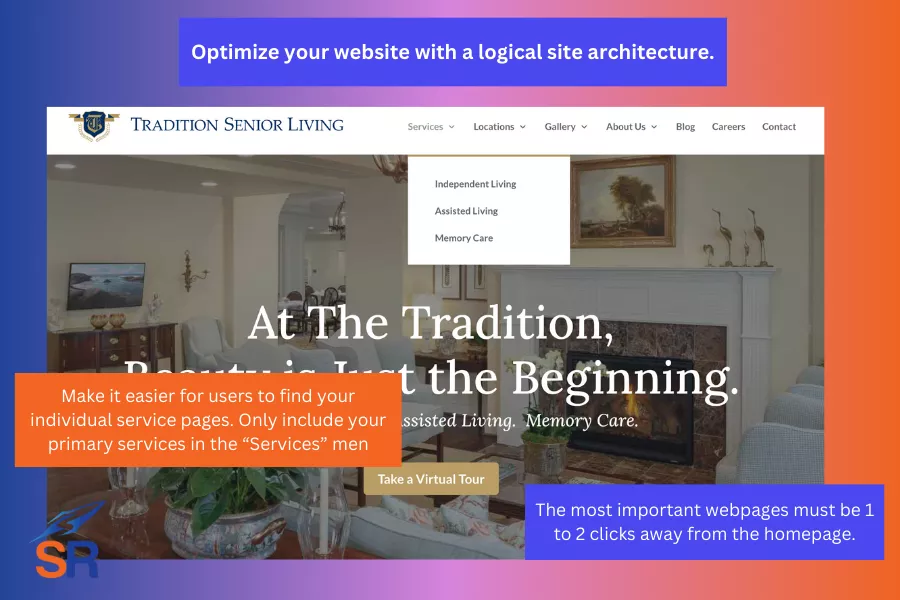
Here are common technical SEO challenges we've seen across many senior living community websites, and we show you how to fix them.
ADA Non-Compliance & Poor Readability
Make your senior living website ADA-compliant, given that you're catering to an audience with potential vision impairments, mobility issues, or cognitive decline.
Addressing these needs increases user engagement on your website and greatly affects your site's ability to convert visitors into customers.
A couple of solutions to these are the following:
- Use large, high-contrast fonts (recommended to be 16px+ for readability).
- Add alt text to all images to help users better understand the context of your image, particularly for facility photos and call-to-action buttons.
- Ensure keyboard navigation works for form submissions and menus, assisting your target audience in seamlessly navigating your website properly.
- Implement ARIA (Accessible Rich Internet Applications) attributes for screen readers.
- Use Google Lighthouse and WAVE Accessibility Checker to scan for ADA compliance issues.
Slow Page Speed & Mobile Performance issues
The desire to upload high-quality photos has disadvantages when these photos are not optimized for search. Large images and heavy media files could affect your site's ability to load webpages faster, especially when shown on mobile devices.
Here are actionable tips to fix them:
- Use WebP format as your image format when uploading to Wordpress or your CMS, instead of PNG/JPG.
- If you have dozens of photos already uploaded on your site, compress these images with tools like TinyPNG or ShortPixel.
- Lazy-load videos and images so they can load only when visible on the screen.
- Enable browser caching to speed up repeat visits.
- Minimize unnecessary scripts, codes, and plugins that will only slow down the website. If you're using WordPress, delete plugins you no longer use.
- Run Google PageSpeed Insights on your web pages (start with your homepage) to see specific technical issues you must fix (e.g., Largest Contentful Paint—LCP).
Duplicate Content and Thin Content Issues
If you keep copying the same content from other senior living communities, you won't be able to rank for your target keywords because of duplicate content issues.
Here are hygienic things to ensure every webpage is clean from any duplicate content issues:
- Write unique descriptions for each location, highlighting specific amenities, staff, and resident testimonials. This would consume resources, but investing in landing page copy is essential as users begin to fact-check most information (especially in today's age when they can easily validate facts).
- Add user-generated content (reviews, testimonials, and FAQs) to make each page distinctive.
- Implement canonical tags to avoid duplicate content penalties and point similar pages to one page you think is more relevant and that your search engines should crawl and better index your website.
- Use structured data (LocalBusiness schema) to differentiate each location's details for Google.
Poor Internal Linking and Crawlability Issues
Diagnose your website for orphan pages (pages that don't have internal links pointing to them). Doing so sends rich signals to Google that the webpage is critical to crawl and index.
Here's my SEO checklist for smart internal linking:
- Create a clear, logical site architecture by mapping your service and location pages.
- Use breadcrumb navigation (if it's better with your current web design) to improve user experience and ranking potential.
- Internally link from blog posts to service pages to drive more users to your landing pages, where they can be converted into potential clients.
- Submit an updated XML sitemap to Google Search Console. This is one overlooked technical SEO solution for most assisted living websites. It's pretty basic SEO, but it's not implemented most often.
You can use Screaming Frog, still the best technical SEO tool for me, to identify orphan pages and broken links and find more technical SEO issues on your senior living community website.
Apply Basic and Advanced GBP Optimization
Since 70% of senior living searches are local (e.g., "assisted living near me"), you can't ignore optimizing your Google Business Profile.
Your Google Business Profile is your most important local SEO asset, as it sits above Google's organic search listings. Before you rank for any local pages, it is best to focus your efforts on optimizing your GBP.
Here are the essential GBP for senior living communities:
- Claim and verify your GBP. If you haven't claimed your listing, verify ownership through Google Business to manage and update your profile.
- Ensure NAP consistency. Your business name, address, and phone number (NAP) must match exactly across your website, local directories, and social media profiles.
- Check even small differences (for instance: "St" VS "Street"), as these can create duplicate listings and might hurt your rankings.
- Choose the correct GBP categories. Your primary category must reflect your core service (assisted living facility, retirement community, or nursing home).
- Include secondary categories based on your services (e.g., memory care facility, independent care facility, senior citizen center).
- Turn on GBP messaging to enable messaging and call tracking so potential residents or their families can message you directly on GBP.
- Encourage resident families and visitors to leave reviews for more trust-building and a positive online reputation.
Many Google Business Profiles of senior living communities may have the majority of the above tips implemented in their respective GBPs.
However, you can further optimize your Google Business Profile to create a wider gap of advantage for local map rankings and organic local ranking improvements of your website.
Here are more advanced Google Business Optimization tips:
- Trigger justifications in GBP (justifications are bolded texts that usually appear to highlight relevant keywords matching the user's search intent). You can trigger these justifications by adding specific service-based keywords to your Business Description, posts, and Q&A.
- Post weekly updates to your GBP. Google rewards active business profiles with higher rankings, helping you engage more potential residents and sending rich local signals to Google that you deserve higher rankings on Google Map Packs.
- Add event promotions, such as seasonal promos, to your Google Business Profile.
- Include resident spotlights for clients who can publicly disclose their testimonials.
- Include service and appointment links directly on your GBP profile. For instance, add a "Book a Tour" link to your tour scheduling page or service pages linking to your assisted living, memory care, or independent living pages.
- Make it easy for visitors to request more information through your contact page.
- Test your phone numbers and Google Maps directions. When more residents actually use them, Google receives signals that they are accurate, which could help improve the ranking of your Google Business Profile.
Be Generous to Create Local Awareness
The local SEO game requires getting the right types of backlinks to increase your community site's ability to rank for local keywords. Helping others within the local sphere is one of the best ways to acquire hyperlocal backlinks.
Most SEOs in the space treat local link building as a one-sided relationship where they only give value if there's a link involved. In local SEO, getting local backlinks is much easier if you do it without expecting immediate returns. That means you naturally earn media attention, partnerships, and backlinks as a by-product.
Here are actionable ways to get backlinks for senior living SEO (through local generosity and engagement):
- Host free community health fairs or caregiver support workshops (a by-product of this is having local news outlets cover your story).
- Offer your community's medical director or head caregiver as an expert for interviews ("expert commentaries") where they provide as much value on topics like aging, caregiving, and senior wellness.
- Partner with local hospitals, physical therapy clinics, and home health agencies to get your senior living facility featured on their referral pages.
- Provide educational sessions on fall prevention, dementia care, or senior nutrition at hospitals.
- Sponsor local senior-friendly initiatives, such as park bench donations, fitness programs, or transportation services for seniors.
- Host free senior wellness webinars or workshops (and get more local features on local news websites).
- Partner with churches, libraries, and community centers to provide caregiver training or financial planning for senior living.
- Sponsor high school service projects or intergenerational programs to foster goodwill and create natural press coverage.
The more you invest in your local area, the more brand recognition, trust, and natural backlinks you will earn organically. Not only will it help your site's SEO performance, but it will also position your senior living community as a go-to solution provider in your city.
SharpRocket—Agency of Choice for Senior Living Communities
Need link building or full SEO campaigns? Schedule a strategy call and we'll show you how to grow your site's organic traffic.
SEO For Architects: Proven Strategies to Attract More Clients
The best part of SEO for architects is that it meets your potential clients just at the right time when they are looking for architectural services—they search for them.
While ranking for design-related keywords could be challenging with the tight competition from large media sites like ArchDaily, Houzz, and Dwell dominating the majority of style-based queries, there is still room for growth for anyone who can outsmart these guys.
In this guide, we'll cover strategies for helping architectural firms win more design projects using search engine optimization.
SEO Strategies For Architects
Own Niche, Style-Specific Keywords
Most architecture firms make the mistake of solely targeting broad, highly competitive keywords like "architecture firm in [City']", which are dominated by large firms and directories.
As you can see in the screenshot below, directories top Google's first-page search results for the keyword "architecture firm New York." Google's intent may change in the future, but as of this writing, it favors more directory/list-type pages.
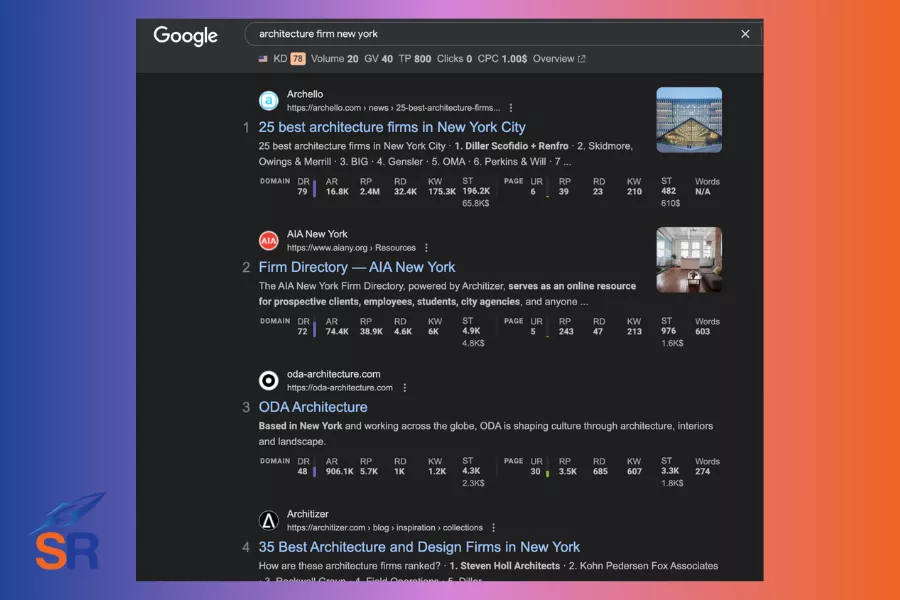
This brings us to an SEO strategy of targeting style-based and niche-specific keywords, which has a higher chance of ranking for mid-level and starting SEO campaigns.
Another reason for this niche-targeting is that you can capture high-intent buyers, as they generally search for very specific keywords related to their preferences in design styles.
Start doing audience research by going through your sales calls or conversations. Collect all information about the types of questions, challenges, and design preferences they usually ask your team.
Avoid being too conscious of search volume. Most targeted questions that your potential clients would ask may not have significant search volume on Ahrefs or SEMRush data, but there are higher chances that people are searching for these questions exactly on Google.
Here are examples of keyphrases you can target for your architect SEO campaign—align them with your current service offerings:
- "Sustainable home architect in [city]" – for eco-conscious homeowners
- "Modern Mediterranean home design [location]" – for style-focused clients
- "Passive house architect in [city]" – for energy-efficient home seekers
- "Luxury villa architect in [region]" – for high-end clientele
- "Small space home design specialist in [city]" – for urban and compact living solutions
Create a dedicated landing page to target each keyword (1 to 1). Optimize pages by including the keyword in the SEO's most prominent places—meta title, H1, first sentence, etc…
Include information your target users seek to help search engines understand your page better. Adding FAQs to increase content depth and length helps your page appear on People Also Ask questions on Google's SERPs.
Smart Image Compression—Speeding Up Website Without Losing Quality
Architectural firm websites are heavily image-driven, showcasing high-resolution project photos, 3D renderings, and portfolio galleries.
However, these large image file sizes often slow down website load times, negatively impacting user experience and website's search rankings. As Google favors fast-loading websites to ensure users don't pogo-stick (go back to search results to satisfy their searcher's intent and needs), having slower pages with large image files can be a disadvantage.
Here are practical recommendations for compressing images.
Before uploading photos to a website, you can compress files using specialized tools such as:
- For Mac—use ImageOptim, which helps remove metadata and compress images efficiently.
- For Windows—use Riot, which offers fine-tuned compression controls.
- Web-based—TinyPNG—to easily reduce PNG and JPEG file sizes by up to 50% without visible quality loss.
After uploading, you can even optimize images at the server level:
- Implement Lazy Loading—to make images only load when visible on the screen, reducing initial page load time.
- Use a Content Delivery Network (CDN) to serve images from the closest server to the user, reducing load times globally. Use Cloudflare, BunnyCDN, or Fastly.
One image SEO best practice is to convert images to WebP or AVIF, which provides smaller file sizes (30-50% smaller than JPEGs without loss of quality), faster page speeds to improve SEO and reduce bounce rates, and better compatibility with modern browsers.
Leverage "Image SEO" to Rank in Google Images
It is apparent in the architectural industry that your potential clients often search for inspiration before hiring a firm. They browse through Google Images for specific design styles, home layouts, or commercial spaces—these open up opportunities for your architectural brand to capture these visual searchers.
Optimize your images to increase their chances of being more visible in Google Images. Here are a couple of actionable tips:
- Upload keyword-rich file name—use "modern-loft-architect-new-york.jpg" instead of "IMG_2345.jpg".
- Write alt text that exactly describes the image (a good alt text is: "A modern loft-style home designed by [Firm Name] in New York, featuring sustainable materials and open-concept living.").
- Embed on pages with captions that naturally contain keywords (e.g., "This award-winning modern loft design in New York was created to maximize natural light and space efficiency.").
- Use structured image metadata.
- Add EXIF data (location, camera, project details) to help search engines understand image context.
- Upload your visual assets on Pinterest and optimize them further for Google Lens searches.
- Add branded watermarks and optimize descriptions so users can trace images to your website.
In addition to these essential image optimization techniques, you can also use visual assets to drive more backlinks to your website.
Do a reverse image search for your branded images, infographics, inspirational design photos, and other visual assets. See which publisher or webmaster has used any of these content pieces. Send emails to these publishers to ask for proper attribution of links.
Google Business Profile Optimization with High-Intent Keywords
Though potential clients in the architectural space would desire to look for specific firm websites, ranking on Google Map Packs brings you an upfront advantage of being the first seen on Google, as it sits on top of organic search listings.
Here are hygienic ways to optimize your Google Business Profile for your architectural firm:
- Claim and verify your Google Business Profile (you can now verify your business with a video recording to capture more details).
- Complete the information in your GBP profile (primary category, additional categories, service areas, business description, contact details, and website).
- Make sure your NAP (Business Name, Business Address, and Phone Number) is accurate and consistent with the NAP details on your website.
- Post high-quality content in GBP to send freshness signals to your profile. Upload before/after project images with updates about ongoing projects and industry trends.
- Do review solicitations, especially from satisfied clients. The best time to ask for reviews is during the highest satisfaction period.
By doing these tips, you will likely get ranking improvements for Google Map Packs with your Google Business Profile.
Video SEO for YouTube and Google Search
One of the best ways to capture traffic for your architectural firm is leveraging video SEO to attract more potential clients from YouTube and Google searches.
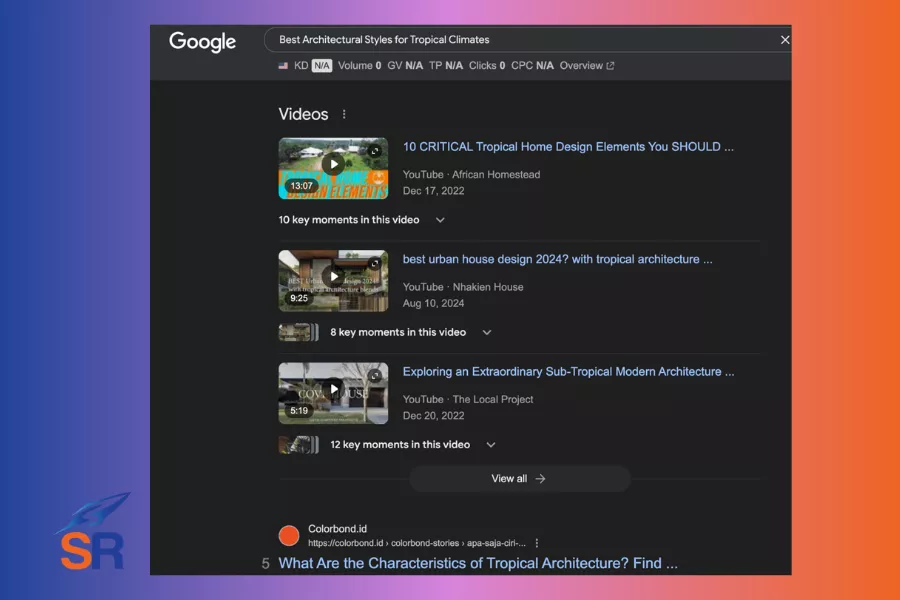
As you can see in the screenshot above, there's a YouTube video section for the term "best architectural styles for tropical climates", which forms the blended search results for this query.
Many potential clients search for design inspiration or insights into specific architectural styles and construction processes, and search results for these types of queries often showcase videos of walkthroughs, time-lapse projects, or design concepts that let searchers learn from the content visually.
Here are a couple of tips to make video SEO work for your architectural firm:
- Upload architecture walkthroughs with optimized titles. Use more descriptive, keyword-rich formats to rank higher in search—as you rank higher on YouTube search, you also get to rank in Google's blended search results.
- Use timestamps to break videos into sections. This will help Google better understand your content while letting users jump to only relevant sections, increasing their watch time and engagement.
- Include keyword-rich descriptions and add links to your website, lead magnets, service pages, and your firm's social media accounts.
- Embed YouTube videos in related blog posts or landing pages. This would help improve user engagement on those pages, add more views to your YouTube videos (which helps increase its rankings in the platform), and help improve overall ranking improvements.
Go to Google's SERPs for every possible keyword to target, assess if it favors videos to show up for searchers, and create and upload those types of videos to attract additional traffic to your website.
Create Cost Calculators
Costing is a big chunk of the decision-making process of most of your potential clients. Whether these other buying factors persuade you, there's always a cost involved in every project. That said, leveraging it to create an interactive cost calculator can help you lead them to make the right decision to hire your architectural firm.
It also helps you capture leads at the research stage, enabling potential clients to understand pricing while subtly encouraging them to contact you for a more detailed consultation.
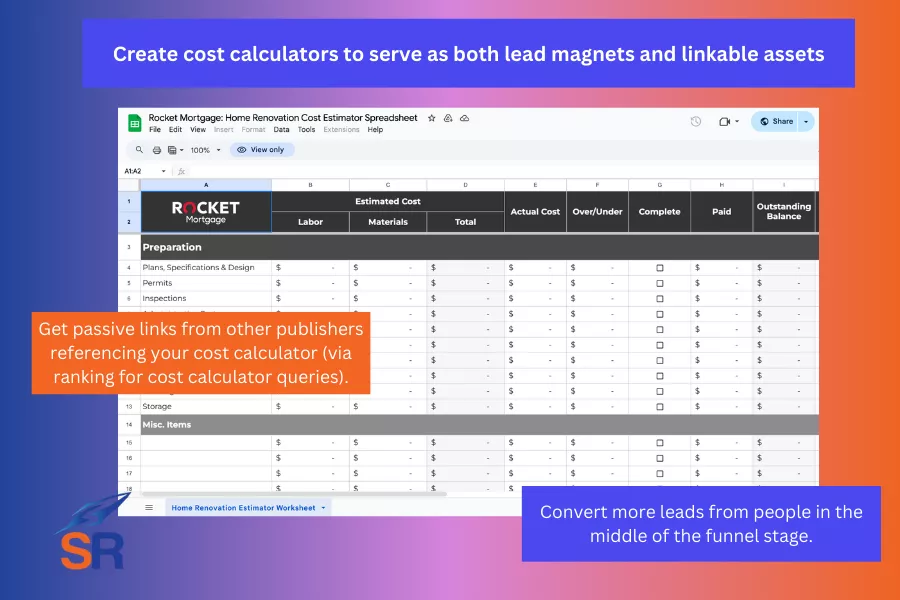
Interactive cost calculators are also linkable assets that help you passively acquire new backlinks to your website—naturally, from other publishers. adding your resource to their own content works, making it easy to strengthen your backlink profile without doing much manual outreach.
Here are a couple of ideas to help you ideate your cost calculator:
- Custom Home Design Cost Calculator
- Home Renovation Cost Calculator
- Home Extension Cost Calculator
- Luxury Home Design Cost Estimator
- ADU (Accessory Dwelling Unit) Cost Calculator
- Office Interior Fit-Out Cost Calculator
- Retail Space Build-Out Cost Calculator
- Restaurant & Café Interior Design Cost Calculator
- Sustainable Home Design Cost Estimator
- Structural Engineering Cost Calculator
Next, optimize the cost calculator to target high-intent, cost-related keywords such as "home renovation cost estimator in [City]". It is also best to include a strong CTA (or a section) to lead your visitors into booking a consultation or getting an exact quote from your team.
These cost calculators position your architectural firm as a thought leader in your industry by providing free tools—interactive tools people can use—and this has immense value in the buyer's decision-making process.
Link Building for Architectural Firms
We've somehow proven (time and time again) that tremendous results can be expected when link building is done right—see our case studies.
In architectural firms, link building will make your website more competitive to rank in Google's SERPs. These links help optimize your site's crawl budget, build your site's domain authority (helping you rank for more competitive keywords), generate more leads from referral traffic, and provide many other benefits your brand must take advantage of.
Whether you're starting new in link building or have been trying to build backlinks to architectural firms, here are actionable and practical link building tips:
- Shy away from Fiverr backlinks that only cost you pennies to get hundreds of links.
- Quality matters. See to it you're only getting the right types of backlinks—relevant ones from websites with an Ahrefs Domain Rating of 25 or above and at least 1,000 organic traffic (or higher).
- Invest in creating linkable assets to help you earn passive links via ranking for informational keywords.
- Get links only from relevant architecture directories, such as Architizer, The American Institute of Architects (AIA), and the RIBA Directory.
- Find and reclaim unlinked mentions, particularly for publishers and other content creators who used your visual and video assets. Reach out to them and ask them to credit links with you as their sources.
- Pitch unique case studies or design trends to A-list architecture and design magazines (one exposure with a link can immensely increase your firm website's domain authority).
- Offer expert insights through an expert commentary-type digital PR campaign, where you send inputs to journalists looking for external advice for the content they're writing about.
Getting these links should be enough to impact your firm's search rankings.
Build Topical Authority Through a Localized Blog Strategy
One of the reasons for building your blog is to capture search traffic from people not ready to hire your firm immediately.
Given that most people would spend weeks or even months researching their options, comparing different firms, and educating themselves about the design and construction process before making a decision.
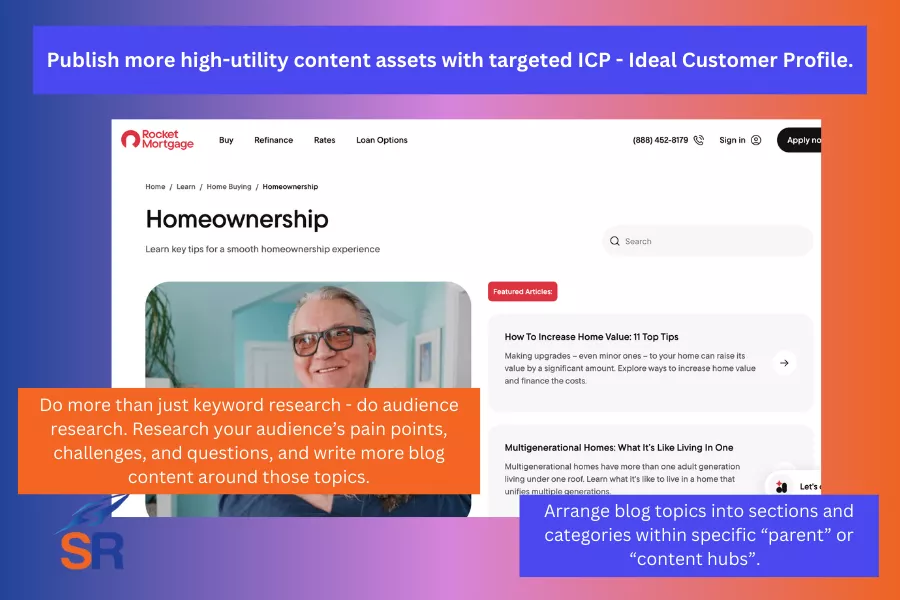
Publishing blog content tailored to these making stages lets you capture leads and build initial trust with these people (as you provide upfront value before rendering services).
To build topical authority, you need to publish informational content around topics your potential clients would be interested in consuming. Create content around these concerns and position your firm as the go-to expert in the industry.
Here are a couple of topics to help you get started with your blogging strategy:
- Signs You Need an Architect for Your Home Renovation
- Architect vs. Interior Designer: Which One Do You Need?
- Understanding the Architectural Design Process: A Step-by-Step Guide
- How to Budget for an Architect: Costs, Fees, and Hidden Expenses
- What Questions Should You Ask Before Hiring an Architect?
- How to Find the Best Architect for Your Project in [City]
- Do I Need an Architect for a Small Home Addition?
- The Benefits of Hiring an Architect for Your Custom Home
- When to Hire an Architect vs. a Draftsman: Key Differences
- What Does an Architect Do? Breaking Down Their Role in a Project
Focusing on topics that draw people closer to their buying decision process helps you capture search traffic by ranking these pages for informational queries.
Once you identify and schedule topics in your editorial calendar, the next step is to write, optimize, and promote these blog contents.
We have a couple of guides on these topics, but let me give you the ones essential to make them rank for their target keywords (and help build your site's topical authority):
- Include primary keywords in the title (H1), first 100 words (or first sentence), H2 heading, image file names and alt text, and URL slug—these basic SEO elements will help Google understand your page's topic.
- Write engaging meta titles and click-worthy descriptions (though meta descriptions aren't a ranking factor, they do help get more clicks).
- Link to other relevant internal blog posts or service pages.
- To enhance the credibility of your page's content, include external links when you source credible insights and sources (e.g., links to architecture magazines, government permit guides, etc.).
- Keep paragraphs short for better readability (as users skim content these days).
- Use bullet points and bold texts to highlight key information.
- Add a call to action (CTA) in your blog posts to guide readers through the next stage of your service journey.
As soon as you rank for informational keywords, make it a habit to check your Search Console (or Ahrefs) to see improvements in content depth, new LSI and secondary keywords to include in your content, and other things to re-optimize your content—and rank for more keyword variants.
SharpRocket—Agency of Choice for Architectural Firms
Need link building or SEO agency to grow your firm's organic traffic? Book a strategy call with our CEO and we'll give you the roadmap to reach your online marketing goals.
Personal Injury Lawyer SEO: How to Dominate in a Competitive Market
Personal injury lawyer SEO is extremely competitive.
You won't rank for personal injury keywords if you're hopping on cheap SEO agencies and getting low-quality links from Fiverr freelancers.
There are approximately 164,559 personal injury lawyers in the US, spread across 60,000 law firms—all competing for the same local keyword as you.
With that, basic SEO is no longer enough. You must dive into advanced SEO that sustains your rankings by first dominating personal injury law firms within your geographical area.
This guide will give you basic and advanced personal injury lawyer SEO strategies.
What is Personal Injury Lawyer SEO?
Personal Injury Lawyer SEO is the process of optimizing your website to increase its visibility in search engine results, driving more qualified leads to your law firm. Given that 52.6% of web visitors for personal injury law websites come from organic searches, a well-executed SEO strategy is critical for success.
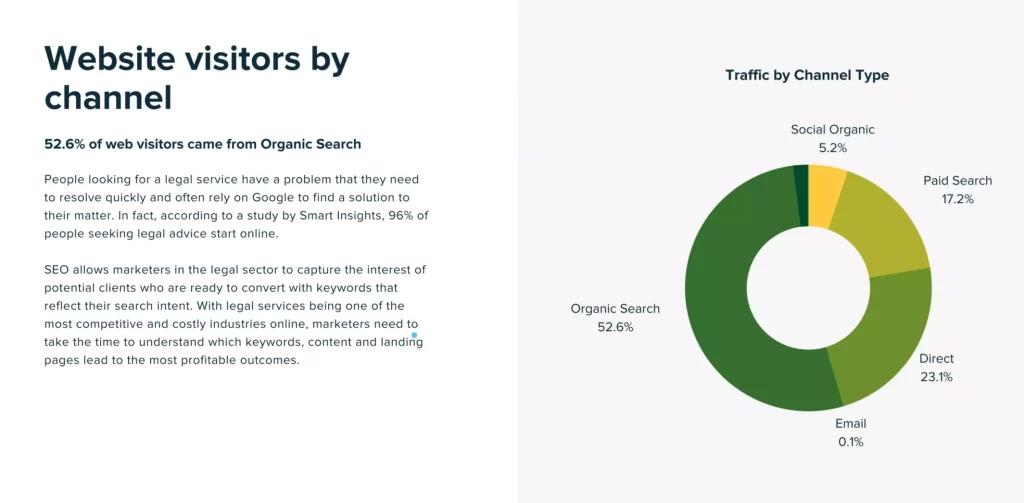
SEO Strategies for Personal Injury Lawyers
Unlike other industries such as physical therapy and furniture, where you can easily dominate the SERPs with basic optimization, you'll find it challenging to rank for personal injury lawyers as there are well-optimized law sites.
It's only a matter of finer details they may have overlooked when optimizing their websites—that makes a big difference in whether you can out-hustle them.
Fully-Optimized Google Business Profile
One of the pillars of local SEO is optimizing your Google Business so that it sends rich signals to search engines about what your personal injury law firm is all about.
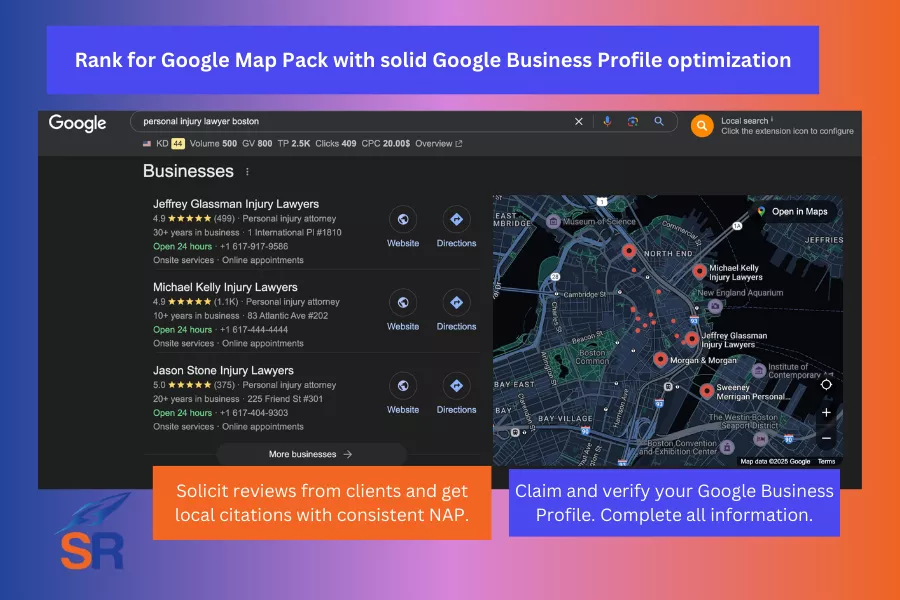
Here are the fundamental rules for completing your Business Profile:
- Claim and verify your Google Business Profile.
- Complete every section - fill out your GBP entirely, including categories, business description, office hours, and specific attributes (e.g. Free Consultation available).
- Accurate and consistent with the website's NAP—Business Name, address, and Phone Number.
- Upload professional office photos, team pictures, and can-be-disclosed client testimonials to build initial trust with prospective clients.
- Regularly post updates—publish legal tips and community engagement updates directly to your Google Business Profile.
- Solicit reviews from satisfied clients. Monitor and respond to every review.
While these tips are enough to build the ground up your Google Business Profile, your local competitors may have perfected all of them. So, doing more of what a typical Google Business optimization is the key to dominating Google Map Packs.
Here are more not-so-obvious ways to optimize your Google Business Profile for both Map Pack rankings and conversions:
Set driving directions to your location on Google Maps. The more potential clients can see your location and set directions to it, the more positive search signals Google receives, which will help your Google Map visibility.
Test-dial your Google Business phone number. Make sure your potential clients can contact your business to prevent a negative customer experience and send a positive search signal to Google that you're running a legitimate business.
Enable Messaging and booking only if you have staff who can respond quickly. The goal of enabling messaging on Google Business Profile is to answer any questions of your potential clients and lead them closer to cases. The best thing is having someone answer those GBP messages right—again, to avoid a negative client experience.
NAP consistency across all legal directories and citations. Don't spend too much time getting hundreds of citations and directory links. There are only a few trusted legal directories where you can include a Name, Address, and Phone Number (NAP) identical to your website and GBP's NAP.
Include and complete all the necessary details across these sites:
- Avvo, Justia, FindLaw, Yelp, and Lawyers.com.
- Local Chamber of Commerce and legal association sites.
- LinkedIn, X, and Facebook Business.
Create a Modern and High-Converting Law Firm Website
Most law firms, especially those starting their online presence, use content management systems (CMS) that aren't good enough to optimize for search.
Some of these, and many legal sites use these, are Clio Grow, MyCase Websites, Wix, Squarespace, and Weebly. Fortunately, many guides exist on optimizing these CMSs (e.g., Wix SEO).
However, if you really want to scale the organic traffic of your personal injury law site and simplify the optimization process, choose a headless to ensure maximum optimization, most especially the technical SEO part.
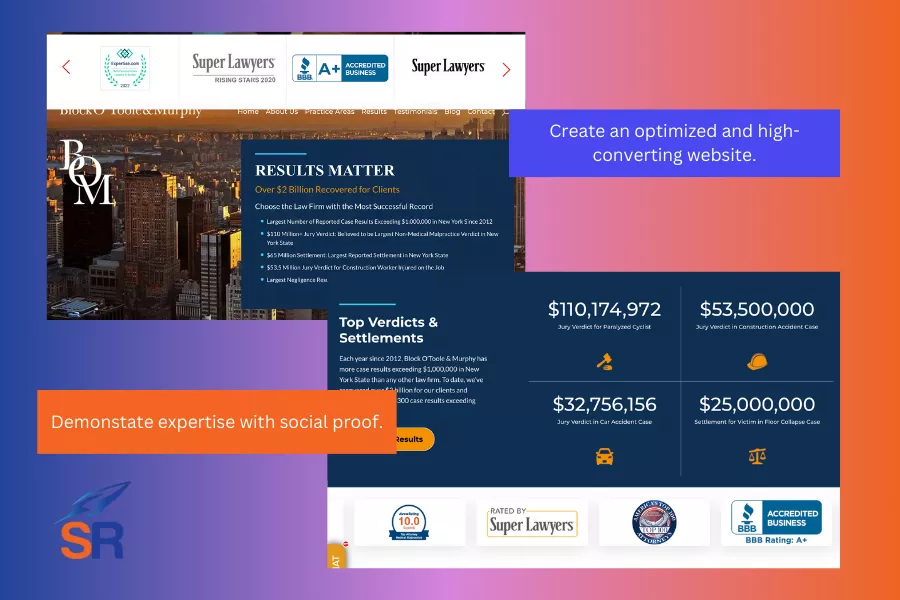
Here are actionable tips when designing your personal injury law firm website:
- Optimize your website's speed—it must load under 3 seconds. Compress images, use a content delivery network (CDN), and eliminate render-blocking scripts.
- Make sure you have a mobile-first design—over 60% of legal searches happen on mobile. Ensure it has a touch-friendly interface and clear CTA buttons.
- Place click-to-call buttons, free consultation forms, and chatbot integrations in high-visibility areas of your homepage and service pages.
- Keep your website structure easy to navigate—users should reach important pages like service pages, case evaluations, and attorney bios in 1 to 2 clicks from the homepage.
The screenshot below is an example of Ryan Stewart's image of a considering redesign for his personal injury client.
Two highlights of this personal injury firm make it likely to rank and generate qualified cases for the firm.
Put The Main Keyword in the Hero Section
Including the main keyword on the homepage is SEO 101, yet most law firms neglect this because they think it would negatively affect user experience.
The best way to combine great copywriting with SEO is to use a smaller font size for H1 for your keyword (see screenshot below for "Michigan's Premier Motorcycle Accident Attorney") while featuring a compelling copy of your personal injury law firm's unique value proposition.
By doing so, you're optimizing your homepage to rank for your head term and increasing your main page's conversion rate.
Demonstrate Expertise with Social Proof
One of the best ways to increase EEAT (Experience, Expertise, Authority, and Trustworthiness of your website) is to highlight social proof to demonstrate the expertise of your personal injury lawyers (or the firm itself).
Here are some tips to demonstrate expertise through social proof:
- Display board certifications and professional memberships (e.g., ABA, local bar associations).
- Highlight awards and peer reviews from platforms like Super Lawyers and Avvo.
- Publish detailed case studies showcasing past success stories, verdict amounts, and legal strategies used.
- Link to news articles, TV interviews, and published legal commentary featuring your attorneys.
- Create an "In the Media" page showcasing all press coverage.
- Highlight pro bono work, legal seminars, or community outreach initiatives.
While many personal injury law firms underestimate the effect of a high-converting and well-optimized website, you're likely to rank higher on Google's SERPs, knowing you've implemented the best optimization efforts.
Technical SEO for Performance & Visibility
Technical SEO gaps are common for most personal injury law firm sites that hinder their ranking potential.
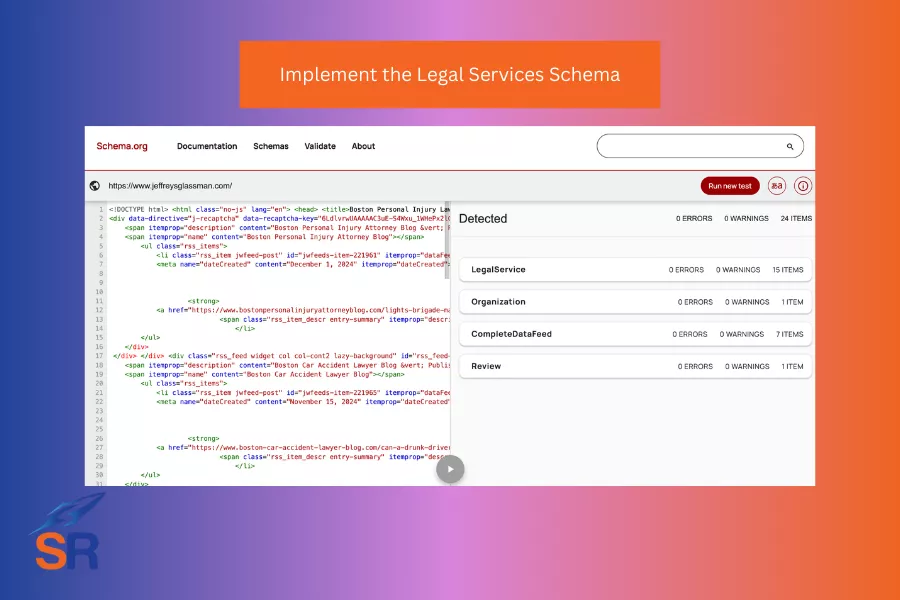
Here are actionable tips to address technical SEO challenges that we've observed with most personal injury law firms:
- Implement the Legal Services Schema to improve the site's search visibility with rich snippets (e.g., firm ratings, case studies, and FAQs appearing in search results). Make sure it is present for Google to associate the firm with its service area—use the Schema Markup Validator.
- Prevent cannibalization by creating a dedicated landing page for every practice area. Cannibalization happens when two pages compete for the same keywords.
- Clean up thin or duplicate content (better yet, remove it if it's necessary for indexing). You can use the noindex directives to guide search engine crawlers efficiently.
- Improve core web vitals and optimize the site's page speed (optimize large images/videos that delay page loads—improve largest contentful paint—LCP).
- Optimize Cumulative Layout Shift (LC) to make sure no unexpected page shifts disrupt the user experience.
- Use Google PageSpeed Insights and GTMetrics to monitor performance metrics continuously.
- Identify and fix 404 errors using Google Search Console.
- Implement 301 redirects for removed pages to prevent loss of ranking equity.
- Regularly audit internal linking to flow equity across your web pages and send rich signals to Google about which pages are most important you want to rank higher on Google's SERPs.
You can invest a couple of hours in the first few weeks of your SEO campaign. The rest of your time should be spent creating content and building high-quality backlinks for your personal injury law website.
Funnel Approach To Law Blog Content
Not every visitor to your website is immediately ready to hire a lawyer. Many potential clients start their search with general research, seeking answers about their situation before considering legal representation. Others may evaluate their options, compare law firms, or decide whether they need an attorney.
Creating one-size-fits-all content won't work. You need to create content that aligns with different stages of the client journey, guiding them from initial research to booking a consultation.
Here's how we approach our law blog content to help every personal injury client through the decision-making process.
First, understand that each buyer is walking in these three buyer stages (there are 4 in every buyer cycle, but we've found only three buyer stages for law firms, specifically).
Quick Breakdown of Each Stage:
Awareness Stage: The client has just experienced an accident and is searching for basic legal information. They may not even be considering hiring a lawyer yet, so your content should focus on educating them about their rights and next steps.
Consideration Stage: The client is now evaluating whether they need legal help. They are comparing self-settlement vs. hiring a lawyer, researching legal fees, and trying to understand the benefits of professional representation. Your content should provide clear comparisons, case studies, and transparent explanations of legal processes.
Decision Stage: The client seeks a lawyer and is ready to act. They search for the best firm in their area, read reviews, and check case results. At this point, your website should focus on trust signals, client testimonials, and strong CTAs that make it easy to contact you immediately.
| Stage | Client’s Mindset | Search Intent (Example Queries) | Best Content Types | Goal |
|---|---|---|---|---|
| Awareness (Research Phase) | “I just had an accident—what should I do?” |
|
|
Establish trust and authority by providing valuable, easy-to-understand information. |
| Consideration (Evaluating Options) | “Should I hire a lawyer, or can I handle this myself?” |
|
|
Convince potential clients that hiring a lawyer is the best choice for their case. |
| Decision (Ready to Hire a Lawyer) | “Which lawyer is the best for my case?” |
|
|
Remove any last doubts and make it easy for them to contact your firm immediately. |
To make your life easier, here's a quick list of potential keywords that match each buyer stage.
Keywords for Awareness Stage (Research Phase) – Informational Searches
- What to do after a car accident
- Signs of a concussion after an accident
- How long do I have to file a personal injury claim?
- Can I sue for a slip and fall injury?
- Car accident checklist
- How to prove negligence in a personal injury case
- Who is at fault in a rear-end collision?
- How to file an insurance claim after an accident
Keywords for Consideration Stage (Evaluating Options) – Comparison Searches
- Do I need a personal injury lawyer?
- Personal injury lawyer vs. handling my own case
- How much does a personal injury lawyer cost?
- What is the average settlement for a car accident?
- How long does a personal injury lawsuit take?
- Can I settle a personal injury claim without a lawyer?
- How much can I sue for pain and suffering?
- Personal injury lawsuit process
- What is a contingency fee lawyer?
Keywords for Decision Stage (Ready to Hire) – Attorney Search Queries
- Best personal injury lawyer near me
- Car accident attorney in [City]
- Top-rated personal injury lawyer [City]
- Personal injury lawyer free consultation
- No win, no fee injury lawyer [City]
- Truck accident lawyer in [City]
- Slip and fall attorney near me
- Best medical malpractice attorney in [City]
- Workplace injury lawyer free case review
- Wrongful death lawyer in [City]
It is best not to rely heavily on your search volume alone to assess whether a specific topic or question is worth writing about.
If your potential client asks the question in your sales call or conversation as you go through their cases, it is more likely that they would search for that particular situation, keyword, or question on Google search.
Analyze Search Intent & Identifying Ranking Page Types
Google is telling you exactly what they want based on the current ranking pages for your target keywords. The best way to rank is for your content to match searchers' intent and needs.
Identify top-ranking pages' content type and format (the first five pages for the target keyword will show the most shared content format). Does the site favor more directories, listings, specific law firm service pages, or informational content?
Don't rely too much on your SEO tools, as what appears to be the intent for the keyword based on the tool may be the exact opposite of what is currently ranking for the term. For instance, it says that the keyword has "commercial" intent. Still, when you see the top-ranking pages, it says otherwise—they rank mostly for info content.
Create Content That Ranks and Converts
Once you analyze search intent for your target keyword (aligning it still with the funner approach we discussed earlier), the next step is to create content that outranks the top-ranking pages and stands out in the personal injury space.
Align your content with the average word count. This isn't a strict rule when writing your content, as word count doesn't indicate ranking success. However, creating content matching the average word count can help your page have more information, which sends relevant signals to Google about your page's content.
Next, create your content outline. Review the top-ranking pages' content structures. You can use Detailed to scan the headings and subsections of a specific webpage easily.

Copy their headings and use them as inspiration when writing your content.
Besides putting a fixed widget or fixed navigation menu, you can add inline CTA to your practice area pages. This allows you to convert blog readers into actual clients.
Optimize your page by applying these actionable tips:
- Include the target keywords in SEO's most prominent places: URL structure, meta title, and first sentence, and sprinkle LSI and keyword variants naturally into your content.
- Use logical content flow—make it easier by adding H2 and H3.
- Add the essential takeaways above the fold (e.g., Summary, Key Takeaways, TL: DR, etc.), addressing users' needs immediately.
- Link internally to other related pages (service pages and other topically-relevant blog content)
- Include branded visuals, tables, videos, and any other content formats complements that best satisfy your audience's needs (either complementing the text content or adding more visual learning).
All blog content must support your firm's ultimate goal: generating qualified cases. Whether the objective is to build topical authority around a subject matter of expertise or add more later to your funnel to get more organic traffic and convert them into clients, the content must support your firm's ultimate goal.
Authority Building By Thought Leadership
Attorney link building is an indispensable SEO strategy, given that the top local personal injury firms compete well in Google's SERPs with high-quality backlinks.
Link building today is more about the number of quality links, which means getting the right types of links (and doing more of them often) instead of resorting to 100+ Fiverr links.
Here are proven link-building strategies that will build up your firm's thought leadership:
- Sponsor local events or charities (e.g., accident awareness campaigns). Generosity goes a long way toward acquiring backlinks your competitors can't easily replicate.
- Write guest posts or get link insertions from local publications and news websites with domain traffic of at least 1K.
- Launch an expert commentary digital PR campaign by answering journalists' requests for input in US and UK publications. With this strategy, you'll get a few DR70+ links to help you scale your legal website's organic traffic.
On top of the legitimate local citations, these legal-specific link building strategies can help you stay atop of Google's SERPs.
SharpRocket—Agency of Choice for Personal Injury Law Firms
Need link building or full-scale SEO campaigns? Book a strategy call with us, and we'll give you the roadmap to dominate your local market.
SEO for Waste Management: Rank for Junk Removal & Local Services
Beyond direct mail, print advertising, and cold calling, there are more effective strategies for attracting new customers for your waste management company.
One of the profitable marketing channels you must certainly invest in is waste management SEO.
See this image below that shows how many people search for "junk removal services'.
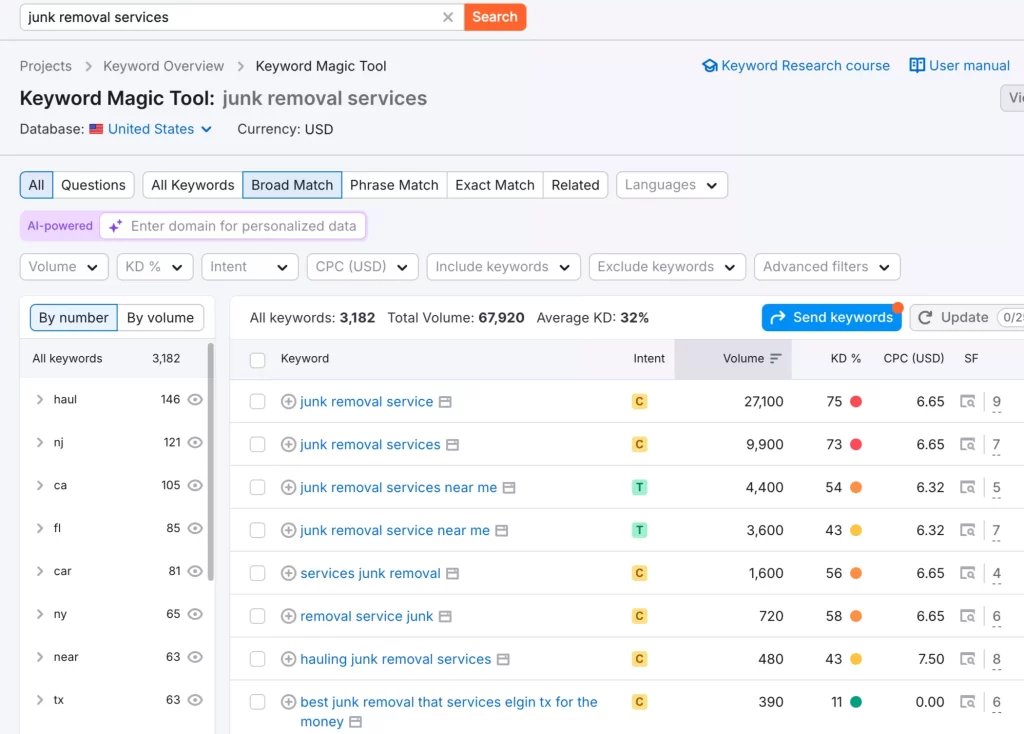
You can capture these people searching for waste-removal-related keywords by optimizing your website for search.
However, you won't simply get to the top and beat the top junk removal guys, such as 1-800-GOT-JUNK? and Junk King, which now rank for almost every local removal service keyword.
In this guide, I'll show you how to rank your waste management company higher on both Google Map Packs and organic search listings.
Waste Management SEO
Waste management SEO is the process of optimizing your website to increase its online visibility on search engines like Google. It includes applying best practices to rank higher for relevant local and industry-specific keywords, attracting potential customers, and generating leads for waste disposal, recycling, and junk removal services.
SEO Strategies for Waste Management
Whatever the type of waste management service, success in ranking your waste management website depends on adhering to the SEO fundamentals and optimizing what your local competitors don't do.
I sorted the SEO strategies here from what's highly important and brings money to the table to more unique approaches your local competitors miss out on.
Rank For Google Waste Management Map Packs
Google Map Pack sits above the organic search listings—it is what your potential customers see within the first seconds when they search for service-related keywords.
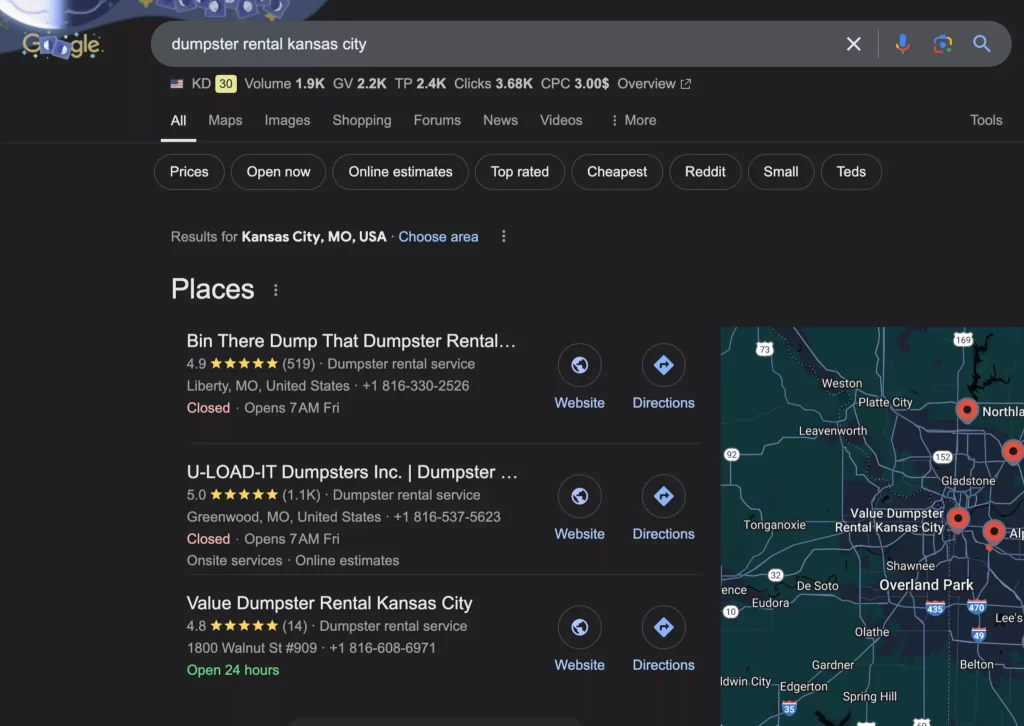
As you can see in the screenshot, the top 3 results you'll see are within the Google Map Pack, which means more than your website, your Google Business Profile is the first web property you must prioritize in optimizing to get more visibility for your dumpster business.
There are many guides written on how to rank for Google Map Pack, but here are the essential tips to make it work for you:
- Claim and verify your Google Business Profile.
- Use a keyword-rich business name (if possible) - e.g. Fire Dawgs Junk Removal Houston, which is usually included in the registered Business Name.
- Select the right business category—at most, you can only select "Waste Management Service. If you can add secondary categories such as Garbage Collection Service, Recycling Center, Dumpster Rental Service, or Hazardous Waste Disposal, include them.
- Complete all details and make sure your NAP (Business Name, Address, and Phone Number) is consistent with the business information you include on your local website.
- Write a concise and compelling description including services offered, covered locations, and unique selling points.
- Upload high-quality photos and videos to add fresh updates to your Google Business Profile— for photos (e.g. before/after cleanup photos, trucks, dumpsters, facilities, and staff).
- Post weekly updates and offers by sharing seasonal promotions (e.g., fall cleanup deals, bulk trash discounts), recycling tips, community waste programs, or even highlight special services).
One of the biggest ranking factors in local SEO is reviews. For example, when you search for "dumpster rental Kansas," as of this writing, you can see the top dumpster rental companies with 519 and 1.1K+ reviews, respectively.
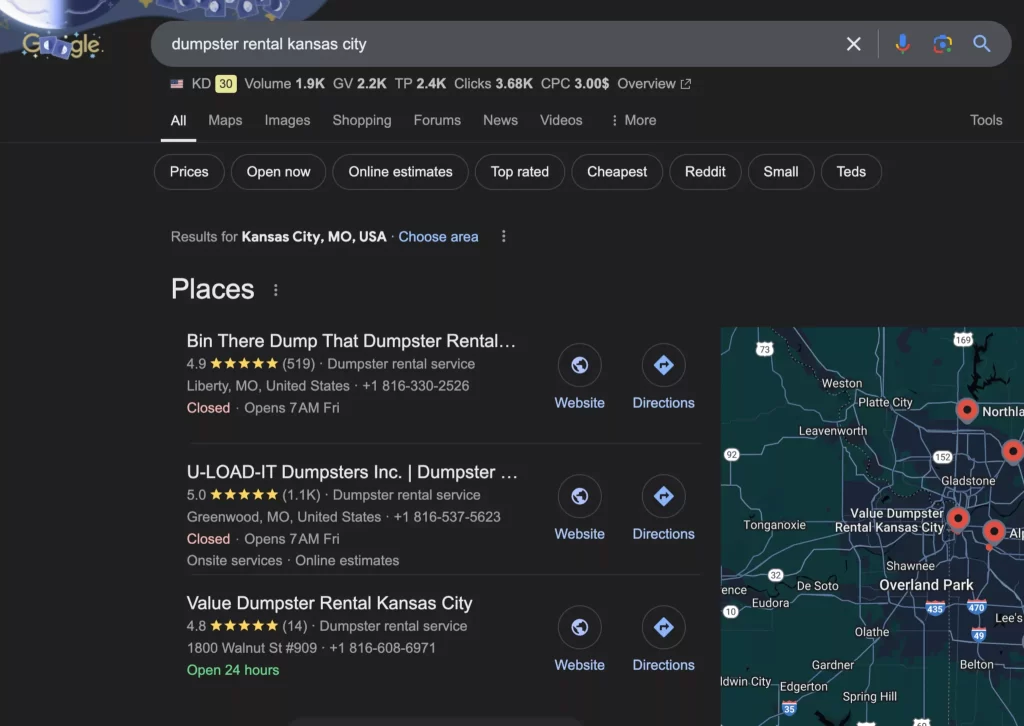
For many local waste management queries, the battle is who gets the most legitimate local reviews.
So, here are some ways to solicit reviews for your waste management company:
- Automate review requests via SMS or email after each completed service.
- You can hand over an exact QR code right after the service so they can immediately write a Google Business Review.
- Incentivize customers by either giving off discounts or other promotional tactics.
- Respond to every review, even negative ones.
As you solicit more reviews, you'll be surprised at how your Google Business Profile climbs the Google Map Pack.
Another powerful business move is enabling messaging and call tracking. You can enable GBP messaging so customers can make direct inquiries via your Google Business Profile. You can also use call tracking software (e.g., CallRail) to monitor and measure GBP-driven leads.
Redesign Websites For Better Conversions
Based on our experience, redesigning the waste management company website is one of the initial steps before doing any search engine optimization.
Generally, we've seen homepages that are either full of ads or have too many call-to-actions, leaving users confused about the next steps or their service inquiry process.
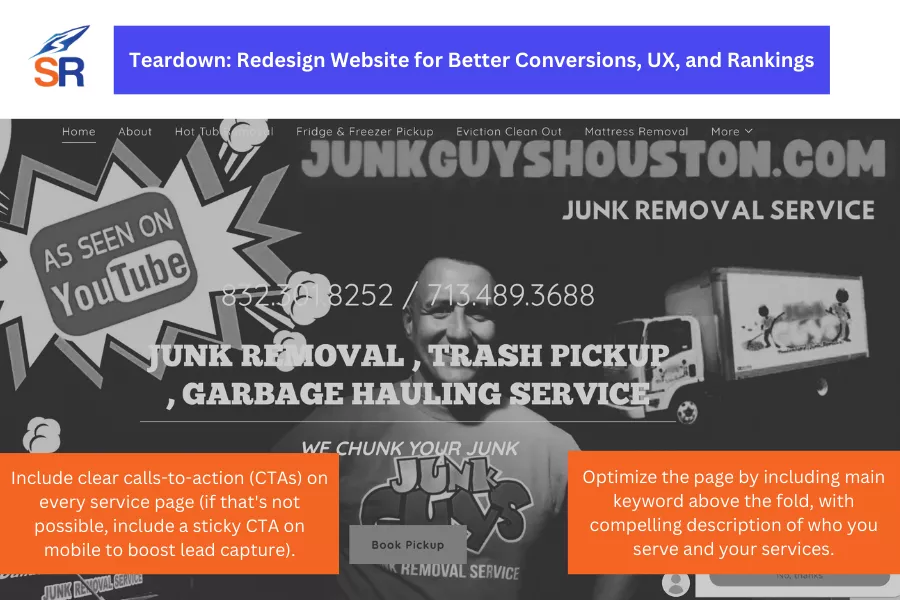
Most junk removal websites, in particular, struggle with poor user experience (UX), slow loading times, outdated designs (where the business owners hand it off to Fiverr freelancers for a quick revamp), and unclear navigation, which not only negatively affect conversions but also user engagement signals, causing potential customers to bounce back to the SERPs ("pogo-sticking").
Before any SEO efforts, start redesigning your website—professionally hand it over to a web designer who knows how to design it properly with SEO in mind—so you can easily inject later SEO elements to make it indexable, crawlable, and enough to rank for its target keywords.
Here are essential parts of designing your webapges with conversions and technical SEO in mind:
- Create a fast-loading, mobile-friendly design (50 to 70% of searches come from mobile phones).
- Optimize image sizes, enable caching, and use lazy loading to improve page speed.
- Include clear calls-to-action (CTAs) on every service page (if that's not possible, include a sticky CTA on mobile to boost lead capture).
- Reduce form fields to names, addresses, waste types, and contact info. Have your sales teams sit down with you to discuss the important details you need to capture on their website so they can close deals efficiently without adding too much friction to your inquiry form process.
- Offer click-to-call, live chat, or WhatsApp booking options for fast response.
- Showcase Google reviews, testimonials, before-and-after photos of past jobs, and other social proof elements to build credibility.
- Add certifications (if you have them), such as EPA compliance, BBB accreditation, and trust badges, to improve conversion rates.
Make your website better-looking and more easily navigate than your competitors. From design and look alone, you can already beat other ranking local websites.
Site Speed & Mobile Optimization
When designing and optimizing your waste management website, ensure that it meets technical SEO and UX hygiene standards before creating content and building backlinks.
Google prioritizes fast-loading, mobile-friendly websites—not as a major ranking factor, but compelling enough to leave your local competitors behind.
Here are a couple of ways to improve your website's speed and mobile performance:
- Compress images to reduce file size without affecting visual quality.
- Choose a lightweight, mobile-responsive theme for quicker loading times on all devices.
- Activate browser caching so visitors experience faster load times during repeat visits.
- Minimize JavaScript and CSS files to streamline code and enhance performance.
Regularly test and monitor your site's performance with tools such as Google PageSpeed Insights and GTmetrix, then adjust based on their recommendations.
Strategic Keyword Research & Site Navigation for Waste Management SEO
Keyword research today isn't just targeting an individual keyword with a single page. The closer your page is to the searchers' intent, the more you can rank for multiple keyword variants with a single page.
Instead of simply focusing on what keywords to target, define your services and create individual pages about them.
For example, here's a list of ways one specific junk removal page can target multiple keywords.
| Service Category | Target Keywords |
|---|---|
| General Junk Removal | Junk removal in [City], Same-day junk removal near me, Residential junk hauling [City] |
| Furniture Removal | Old furniture removal service, Couch disposal near me, Mattress disposal in [City] |
| Appliance Removal | Refrigerator disposal [City], Appliance recycling near me, Washer and dryer removal service |
| Electronics (E-Waste) Removal | Electronics recycling in [City], TV disposal near me, Computer and electronics removal service |
| Yard Waste Removal | Yard waste removal services, Tree debris removal [City], Lawn debris cleanup near me |
| Construction & Renovation Debris | Construction waste disposal service, Renovation debris removal in [City], Drywall and debris pickup |
| Estate & Foreclosure Cleanout | Estate cleanout services, Foreclosure junk removal in [City], House cleanout services near me |
| Garage Cleanout | Garage junk removal, Garage cleanout service [City], Garage decluttering and removal |
| Basement & Attic Cleanout | Basement cleanout services, Attic junk removal near me, Crawl space cleanout [City] |
| Commercial & Office Junk Removal | Commercial junk removal, Office furniture disposal services, Retail cleanout and junk removal [City] |
| Hot Tub & Spa Removal | Hot tub removal near me, Spa disposal service [City] |
| Carpet & Flooring Removal | Carpet removal services, Hardwood flooring disposal [City] |
| Scrap Metal Removal | Scrap metal pickup near me, Metal recycling services [City] |
| Storage Unit Cleanout | Storage unit cleanout [City], Storage facility junk removal services |
| Disaster Debris Removal | Storm debris cleanup service, Fire and flood debris removal [City] |
Once you've published these service pages, you can organize them in a menu so search engines can understand your website's structure (in a logical manner) and help potential customers easily find your services.
Multi-Layered Location Strategy with Targeted Service Pages
To rank effectively and attract local customers, structure your site to feature unique service pages at each geographic level.
Given that search engines reward websites that provide clear, targeted, and locally relevant content. By creating dedicated pages for each county, city, and neighborhood you serve (depending on how specific your target location is), your waste removal website gains more opportunities to appear in local search results.
Here's a good example of how the URL structure looks like:
Main Service Areas Page
/junk-removal/service-areas/
County-Level Pages
/junk-removal/los-angeles-county//junk-removal/orange-county/
City-Level Pages
/junk-removal/santa-monica//junk-removal/anaheim/
Neighborhood-Level Pages
/junk-removal/hollywood//junk-removal/beverly-hills/
Generally, you only need to target county and city-level locations. However, you can add more neighborhood-level service pages for highly targeted waste management companies.
Authority Building Through Local Link Building
The basics of SEO should have helped you gain rankings for local service keywords.
But if you compete with search giants with higher domain authority, you can fight them by building and securing high-quality local backlinks to help you climb higher on Google's SERPs.
Here are the following practical techniques to acquire local backlinks:
Local Directories and Chambers of Commerce
Register your business with authoritative local directories, city listings, and regional Chamber of Commerce. These listings often come with valuable backlinks, sending rich local signals about your website to Google.
Sponsoring Local Environmental Initiatives
Local sponsorships are one of the underutilized yet most effective ways to build local links. Sponsoring community-focused environmental or recycling events, cleanup drives, or sustainability programs can help you earn hard-to-replica links from event websites and local community platforms.
From a local SEO perspective, hyperlocal links have higher link equity than generic links from niche bloggers.
Zipsprout, a local sponsorship company founded by Citation Labs' CEO Garrett French, has focused its efforts on matching local sponsors with local brands. You can check out how its local sponsorship process works.
Start searching for potential events or local organizations to sponsor using their local sponsorship finder.
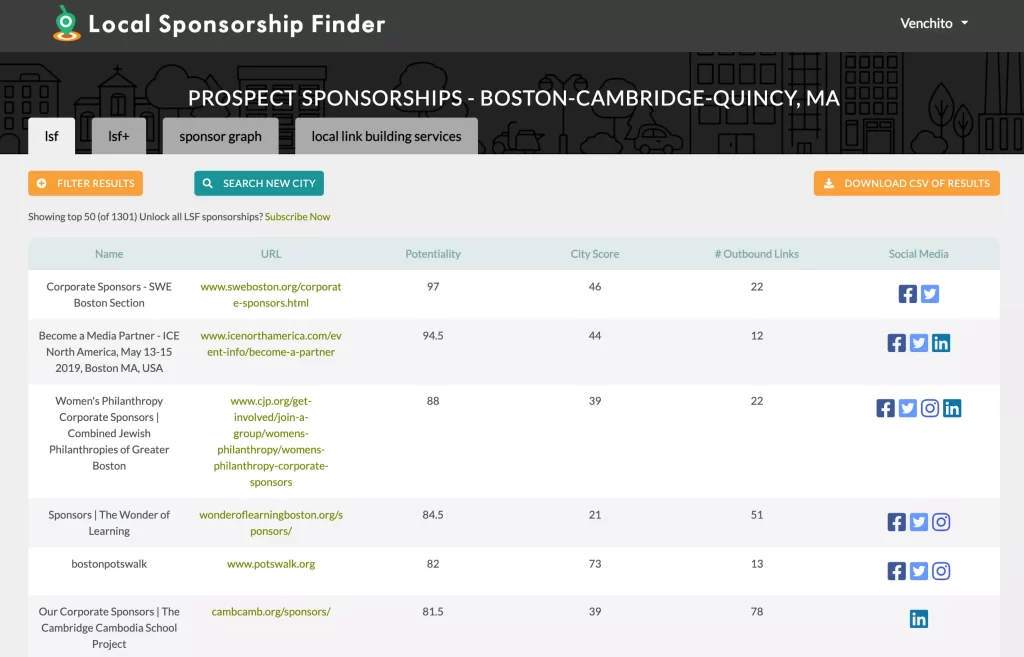
Learn proven SEO for waste management to rank higher, attract local customers, and boost leads for junk removal services.Pitching Local News and Media Outlets
Compared to national and top-tier publications and news websites, getting brand mentions (and links) by pitching local news and media outlets is doable.
Start by reverse engineering what local journalists in your area usually cover in their news articles. Then, align your brand stories and offer valuable content or insights to ocal journalists.
In many cases, niche waste management and recycling or commentary on local environmental regulations are very much seen as helpful content for local media.
Monitor New Links to Local Competitors
Local brands are one of the best sites to reverse engineer backlink profiles, as they typically acquire links naturally—more often than not, as a result of their contributions to local communities—which is an effective pattern for new local link-building ideas.
How to reverse engineer your local competitors in the waste management space:
- Identify top-ranking local competitors (avoid big waste removal companies with multiple locations—find mid-level local companies).
- See local brands with solid backlink profiles. Don't just stick to your local competitors—you'll see interesting finds for link building ideas with other niche companies.
- Set up alerts using Ahrefs or other intelligence tools to notify you of their newest links.
- You can also schedule an hour weekly to monitor every link indexed by Ahrefs (or your favorite link building tool).
- Assess how they obtained the links—what's the reason they acquired the link? Was it sponsorship, reciprocity, goodwill for green initiatives, etc.?
Waste management SEO offers easier backlink opportunities because it connects directly to environmental and sustainability causes or initiatives. Websites and blogs on green living, recycling, eco-friendly practices, and corporate social responsibility frequently seek credible resources.
SharpRocket—Agency of Choice For Waste Management Companies
Do you need a white label SEO or local backlinks to help your waste management website rank higher on Google's SERPs? We've got everything covered in our SEO services for waste management companies. Book a strategy and we'll show you our roadmap.
Physical Therapy SEO: Unique Strategies to Rank Higher & Get More Patients
Physical therapy SEO presents the best opportunities, as most physical therapy clinics rely on referrals and don't have much online presence on search.
This means lower competition if you're doing SEO for physical therapy clinics, making it easy for your physical therapy website to rank higher on Google's SERPs.
In this guide, I'll walk through actionable and unique strategies for using physical therapy SEO to attract more patients.
What is Physical Therapy SEO?
Physical Therapy SEO is the process of optimizing a physical therapy clinic’s online presence to rank higher in Google search results—attract local patients and build trust through expertise-driven and patient-centric content, local authority, and hyper-local engagement strategies on Google Business Profiles.
Getting Into the Google Local Pack (Top 3 Map Results)
Google Local Map pack sits above the organic search listings for any physical therapy or treatment keywords.
So, the first SEO activity you need to do is optimize your Google Business Profile and reach the top 3 map results as quickly as possible.
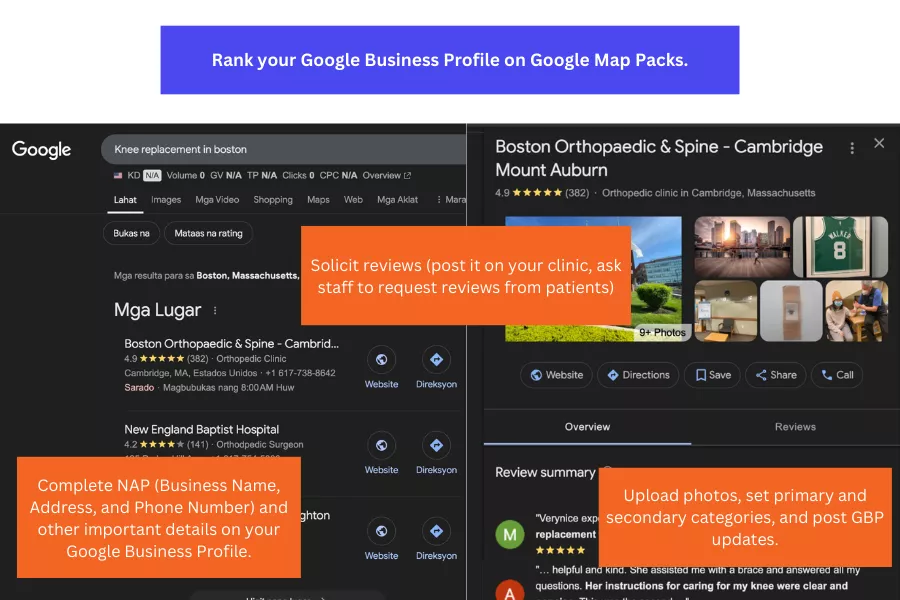
Start by claiming and verifying your Google Business Profile.
Then, once you have it, optimize your GBP by completing all the required information. Essential tips on Google Business Profile optimization include:
- Set "physical therapist" as the primary business category.
- Add complete NAP (Business Name, Address, and Phone Number), consistent with business details included on your website.
- Add appointment links so patients can easily book their slots in your clinic.
- Upload high-quality photos of your clinic, therapists, and treatment rooms.
- Post weekly health tips, promotions, announcements, or clinic news updates. The more frequently you update posts, the more rich signals it sends to Google for your Google Business Profile.
- Encourage reviews by asking satisfied patients to leave a Google review after every session (you can incentivize them to increase the odds of getting legitimate reviews). Solicit reviews as many as you can.
- Respond to all reviews to show engagement and brand credibility.
- Get citations and directory links. Make sure NAP is accurate and consistent with the information on your Google Business Profile. Avoid duplicate or incorrect listings.
Apply all these physical therapy SEO tips, and you'll undoubtedly rank for your Google Business Profile.
Location Page Optimization
Most physical therapy clinics that want to optimize their websites for search have more than 3 locations, some even having 120+ clinics.
That said, location page optimization is important in optimizing the physical therapy website, as most patients land on these individual location pages to decide whether to book an appointment or go straight to the nearest clinic.
Create dedicated location pages that don't simply list clinics' addresses but are well-optimized to target city-specific and micro-location searches.
Optimizing a service page for other industries is really no different, but there are a couple of new items you should highly prioritize adding to the location page.
Apply Basic On-Page SEO
Optimize the URL for the keyword you're targeting so that Google can better understand the page's relevance for that local or geographical area.
✅ Best Practice: yourclinic.com/physical-therapy-los-angeles/
✅ For Micro-Locations: yourclinic.com/physical-therapy-downtown-los-angeles/
❌ Avoid: yourclinic.com/locations/ or yourclinic.com/la-clinic/
Optimize the URL for the keyword you're targeting so that Google can better understand the page's relevance for that local or geographical area.
The next optimization is your location page title for better relevance signals and meta description for clicks.
Example Title: "Top Physical Therapy Clinic in Los Angeles | Sports Rehab & Pain Relief"
Example Meta Description: "Looking for expert physical therapy in Los Angeles? We offer pain relief, sports rehab, and post-surgery recovery therapy. Call today to book an appointment."
To your location page, include the service or specific treatment ("physical therapy") and city name as your target keyword, like "physical therapy in Los Angeles."
Next is to write unique, location-specific content on the location page. It should contain key details like:
- Services you offered at that location
- Parking and public transportation details (to help patients locate your clinic quickly)
- Nearby landmarks (e.g., "We're located next to Los Angeles Memorial Coliseum").
- Staff bios should show enough credibility and trust (e.g., "Our lead therapist, Dr. John Doe, has over 15 years of experience treating ACL injuries and lower back pain.").
Add more content to your location page by using localized headers (H1, H2, H3 tags).
Good examples of subheadings are:
- "Why Choose Our Physical Therapy Clinic in Los Angeles?"
- "Our Los Angeles Clinic Services: Sports Rehab, Pain Relief & More"
- "How to Find Our Physical Therapy Clinic Near Downtown LA"
Embed Google Maps for Local SEO
One overlooked optimization element in physical therapy SEO is embedding Google Maps on location pages. It strengthens your local SEO by confirming location data to Google. It also increases user engagement so that patients can get directions instantly.
Include Patient Testimonials
If you've been operating your clinics for a while and are asking for patient testimonials, including them on your location page makes more sense to build more trust with prospective clients. It's a social proof that helps increase your location pages' conversion rates.
Strategic Internal Linking for Nearby Locations
Strategic internal linking is a powerful free SEO technique that can increase user engagement by helping users easily navigate your website.
For location pages in particular, it helps your patients see very close locations, such as neighboring towns or districts, so they can select the nearest, most relevant clinic to visit.
Here are a couple of tips for smart internal linking for nearby locations:
- Link to closest locations based on geography. For example, if you have locations in Los Angeles, Pasadena, and Glendale, you should interlink Pasadena and Glendale, as they are close. Avoid linking Los Angeles and San Diego locations, as they are too far apart for relevant searches.
- Use contextual anchor texts to guide users. Instead of generic links, use localized phrases like "Our Pasadena clinic is just 10 minutes from Glendale! Click here for more details."
- If you serve multiple locations within one metro area, consider a regional hub page or location cluster page to group those clinics. For instance, you can create a hub page for "Physical Therapy in Greater Los Angeles" with links to Pasadena, Glendale, and Burbank locations.
By linking internally across webpages, you distribute link equity to other nearby location pages, strengthening location relevance between nearby clinics.
Implement Local Business Schema Markup
Schema markup (also called structured data) is a special type of code that helps Google better understand your website's content. Implementing a Local Business Schema ("Medical Clinic")can improve the search capabilities of your location pages, ultimately increasing their individual website rankings.
When properly implemented, schema markup can trigger rich search results (also called rich snippets), which makes your location page stand out in Google lists and attract more clicks.
Target Treatment-Specific Keywords (Beyond "Physical Therapy")
Many physical therapy clinics only optimize for broad terms like "physical therapy in Boston"—while these capture the head keyword you're trying to rank for, they don't always match how patients search.
Think of how your patients search. With easy access to knowledge today, they would search for solutions to their specific problems. A few examples are:
- ACL tear recovery exercises
- Post-surgery therapy near me
- Knee replacement exercise program
- Chronic back pain treatment
- Rotator cuff injury treatment
- Sciatica nerve pain relief
- Hip pain therapy without surgery
- Carpal tunnel syndrome treatment
- Whiplash treatment near me
- Work injury therapy program
There is far less competition but more relevant and high conversion intent with these terms for actual clients.
Create dedicated landing pages for each treatment's specific keywords and place them under your menu of "services," as appropriate.
Another content writing strategy is to publish a landing page for a broader service and add sections for each treatment service (with internal links pointing to these treatment pages).
Increase Content Library with 'Symptom-Based Searches'
Not every potential client will go directly to visit your clinic. Most of them are simply searching for information to help them answer their questions. One in particular is about symptoms. Common search likes:
- "Why does my knee hurt when I walk?"
- "Should I see a PT for shoulder pain?"
- "Best way to recover from a sprained ankle?"
These valid questions may or may not require a single blog post to answer, or they are best included in an FAQ section under a relevant treatment service page.
Find all these symptom-based searches using Ahrefs or SEMRush and answer all of them to increase your content library, rank for more long-tail keywords, and get additional patients from people converting to these blog content pieces.
Link Building For Physical Therapy Clinics
Backlinks are a strong ranking factor in Google (and other search engines, too). Not only do they help your physical therapy website improve its search visibility, but they also vote for you as the best solution for the treatment services you're providing.
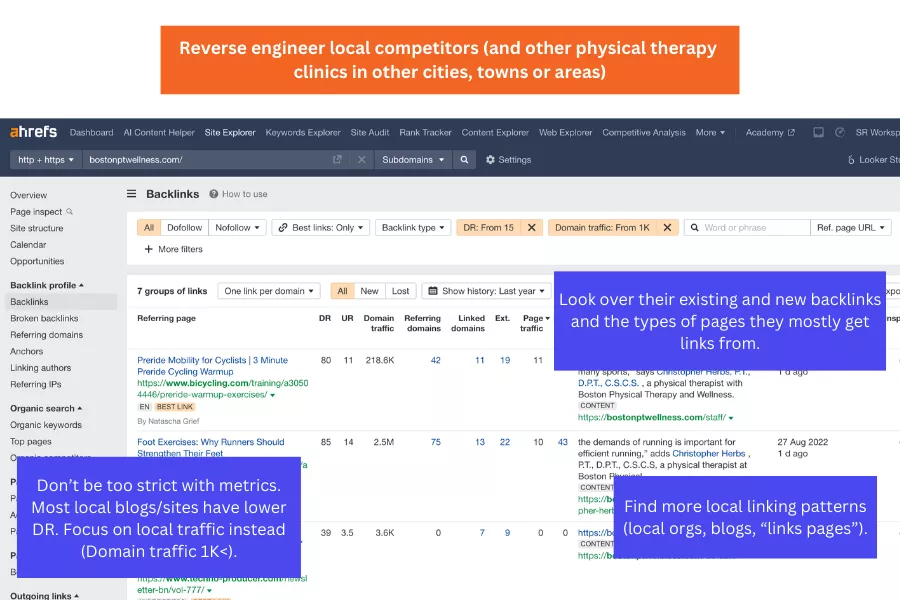
Getting high-quality, highly relevant, trusted, and authoritative editorial backlinks (through strategic link building) is crucial to helping your treatment service pages climb in Google SERPs.
Here are a couple of unique link-building tactics for physical therapy clinics:
- Get listed on local physical therapy directories (but choose legitimate, high-quality niche ones).
- Partner with local healthy bloggers and sports influencers to review your services (you'll find some of these local content creators on social media).
- Reach out to chiropractors, orthopedists, and local gyms for guest blog or link insertion opportunities.
- Sponsor local events and associations within your area. Through these charity works, most local businesses get featured on local news websites and links pages of local organizations—acquiring them juicy local links.
Check out this guide on local link building to learn more actionable link-building tactics for local businesses.
Create a 'Pain & Recovery' Video Series with Patient-Specific Keywords
Getting branded searches and organic social traffic helps improve the search performance of your physical therapy websites.
Aside from optimizing your clinics for search, you can also create engaging videos that target the pain points of your target patients and upload them to YouTube.
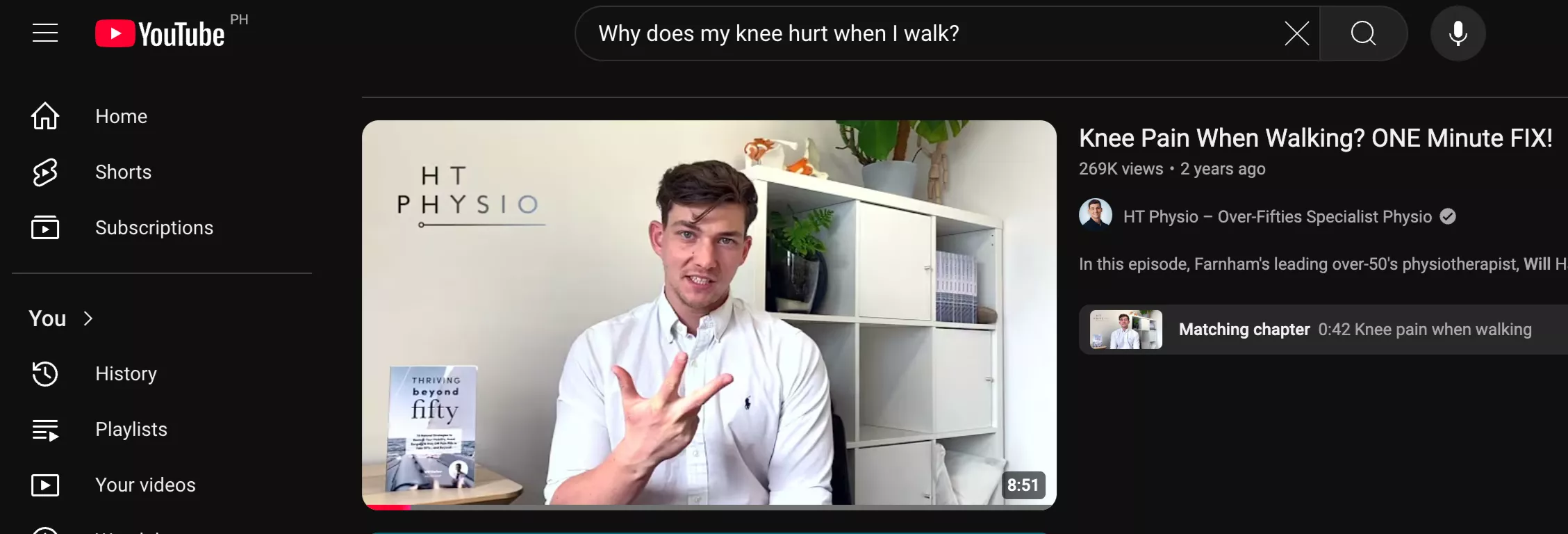
With YouTube as a search engine, you can rank your therapy videos for keyword variants related to your industry.
Going further, you can also do these tips:
- Repurpose video transcripts and turn them into blog posts (making them keyword-rich content).
- Include related YouTube videos to existing articles.
- Post these videos on your Google Business Profile to add update frequency and get more visibility.
Optimize Images for 'Image SEO'
One way to capture more search traffic is to optimize your images for keywords and get them to rank for image search results—many PT clinics overlook this strategy.
Here's how to leverage image SEO:
- Rename images with SEO-friendly filenames (e.g., not "IMG_123.jpg" but "physical-therapy-exercises-for-back-pain.jpg").
- Create before-and-after patient recovery image galleries to show social proof and results of your treatment services—building more trust and engagement with your users.
- Get more backlinks by ranking your physical therapy images (see our image link building guide).
SharpRocket—Agency of Choice for Physical Therapy Clinics
If you need local SEO, full-scale SEO campaigns, or link building services, contact us, and we'll provide a physical therapy SEO roadmap for you.

